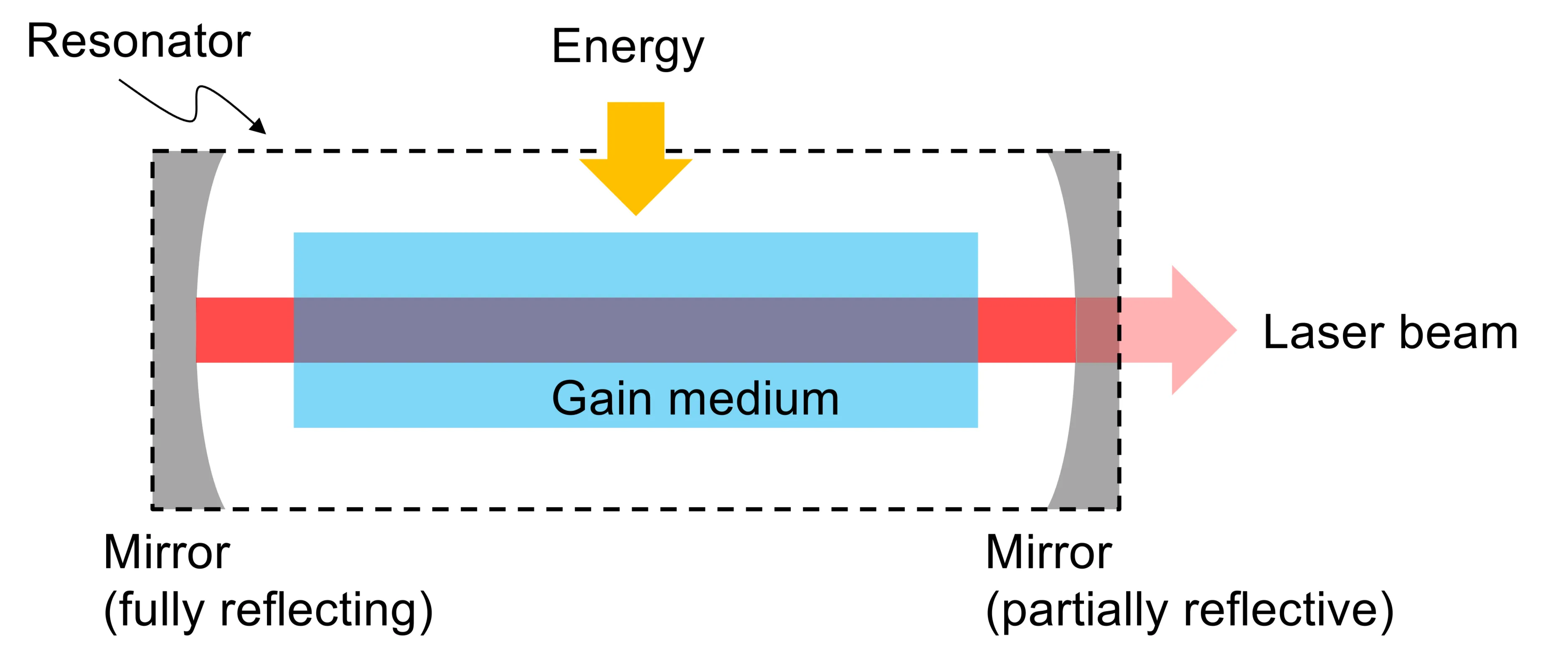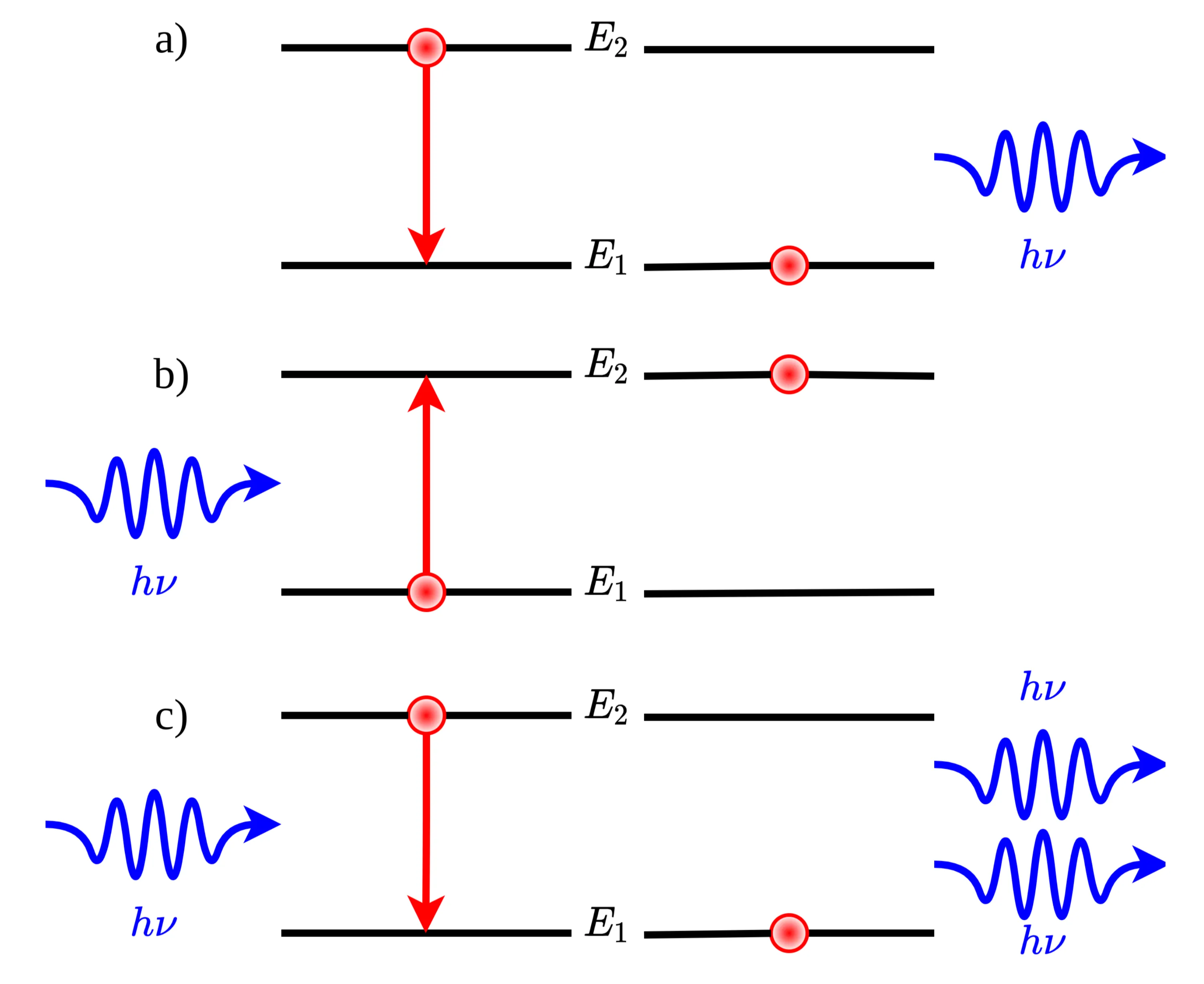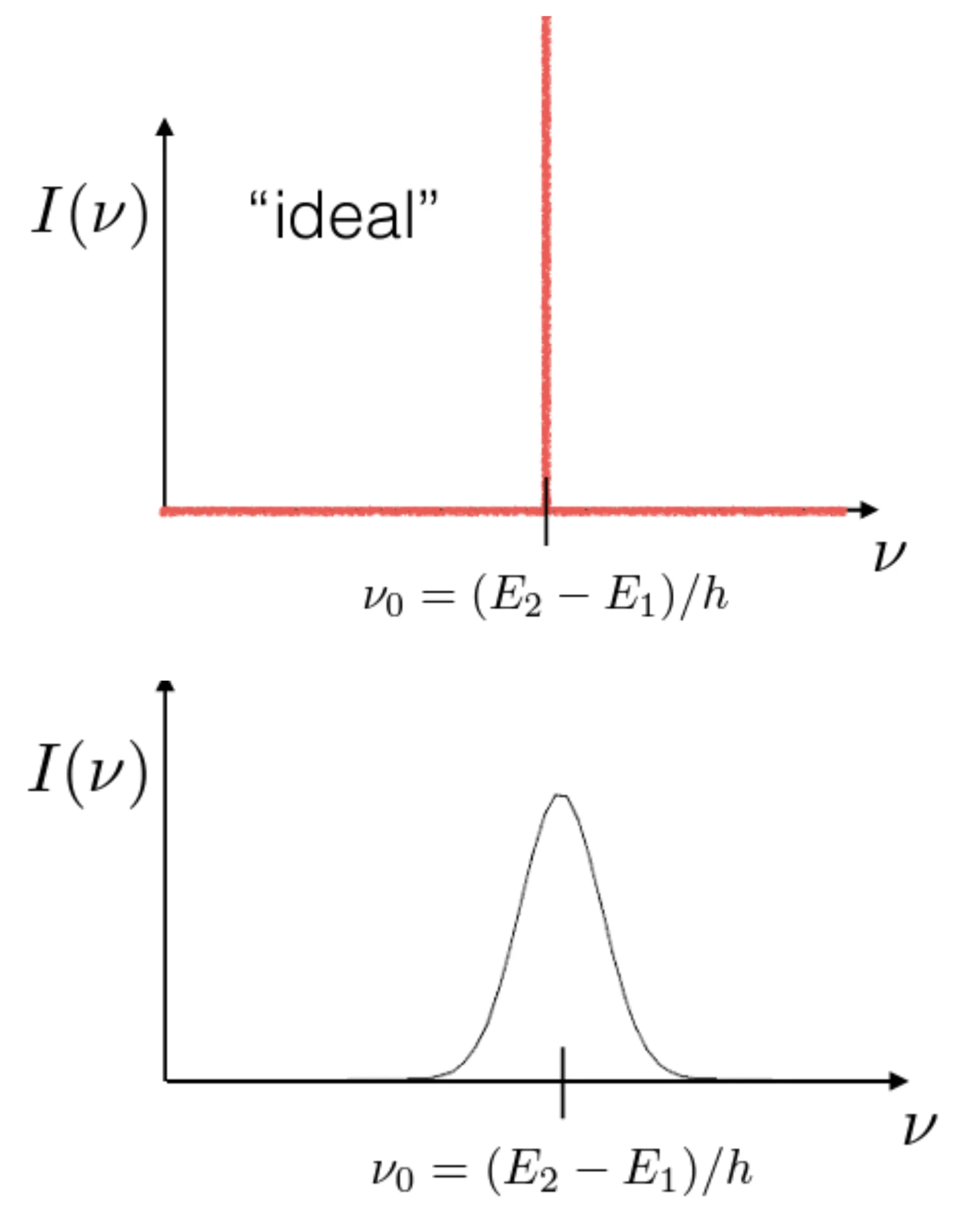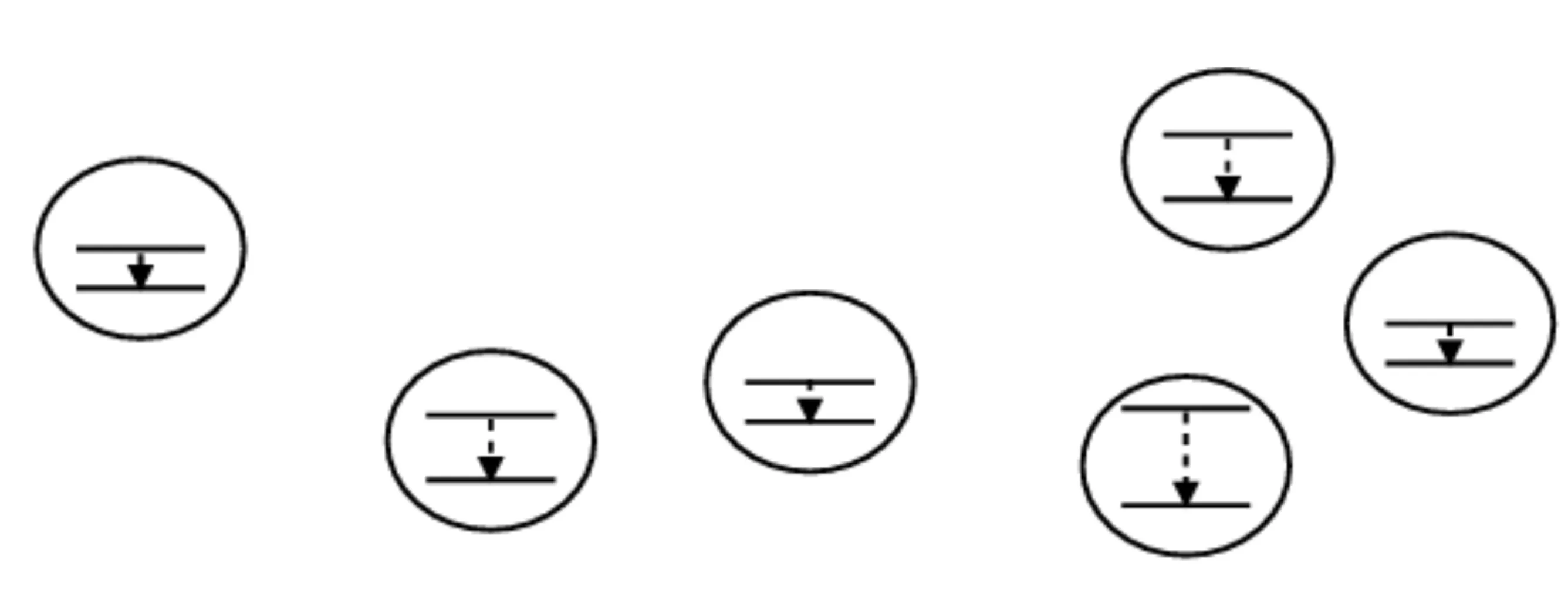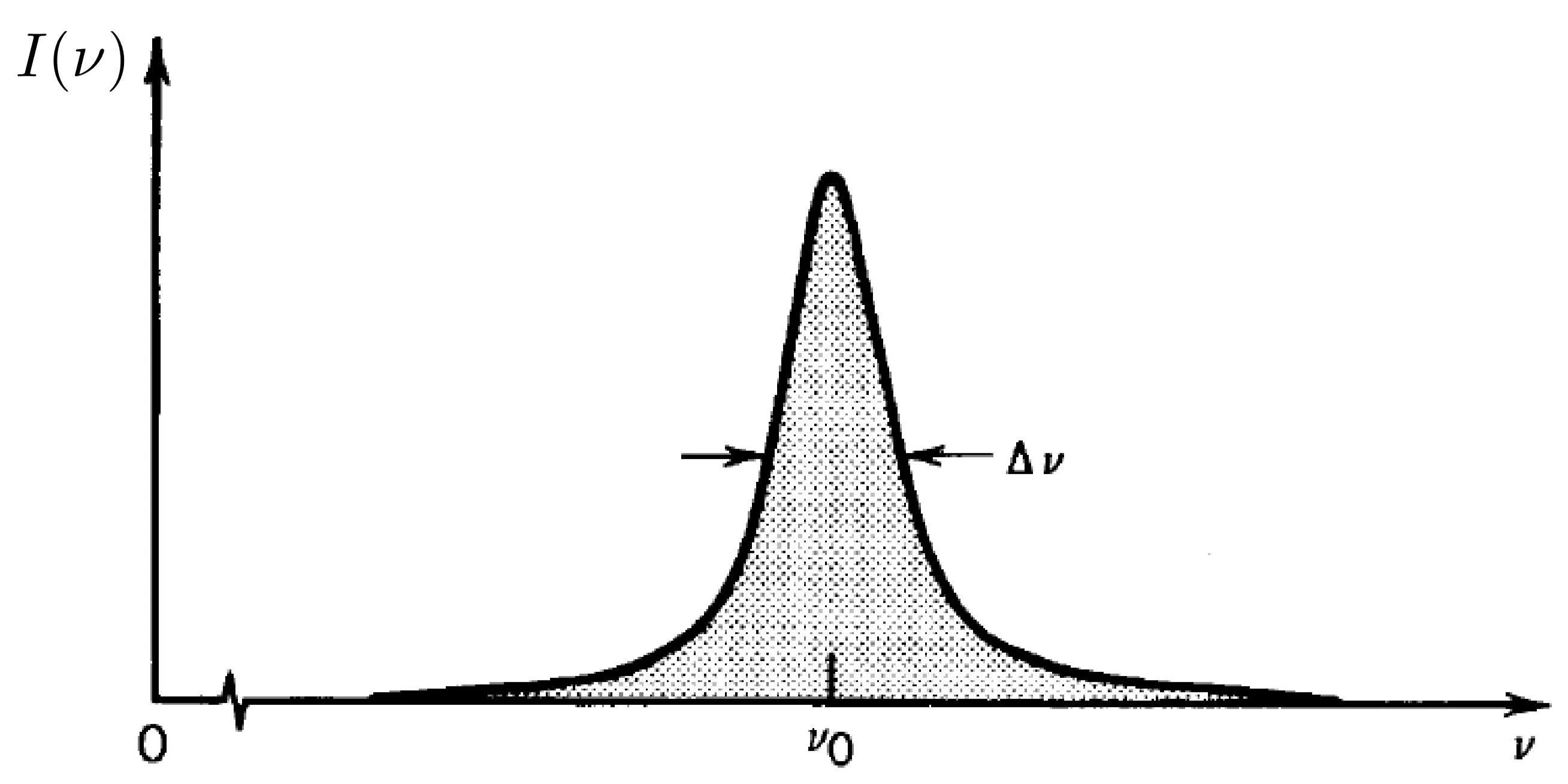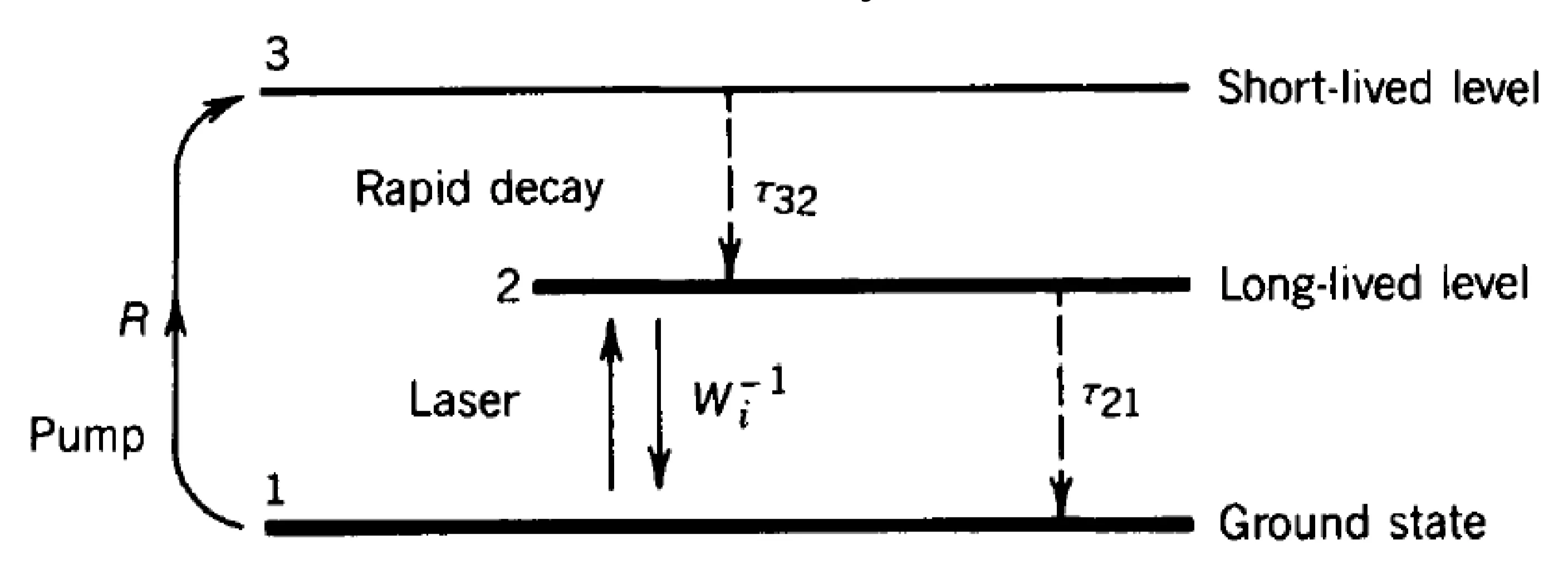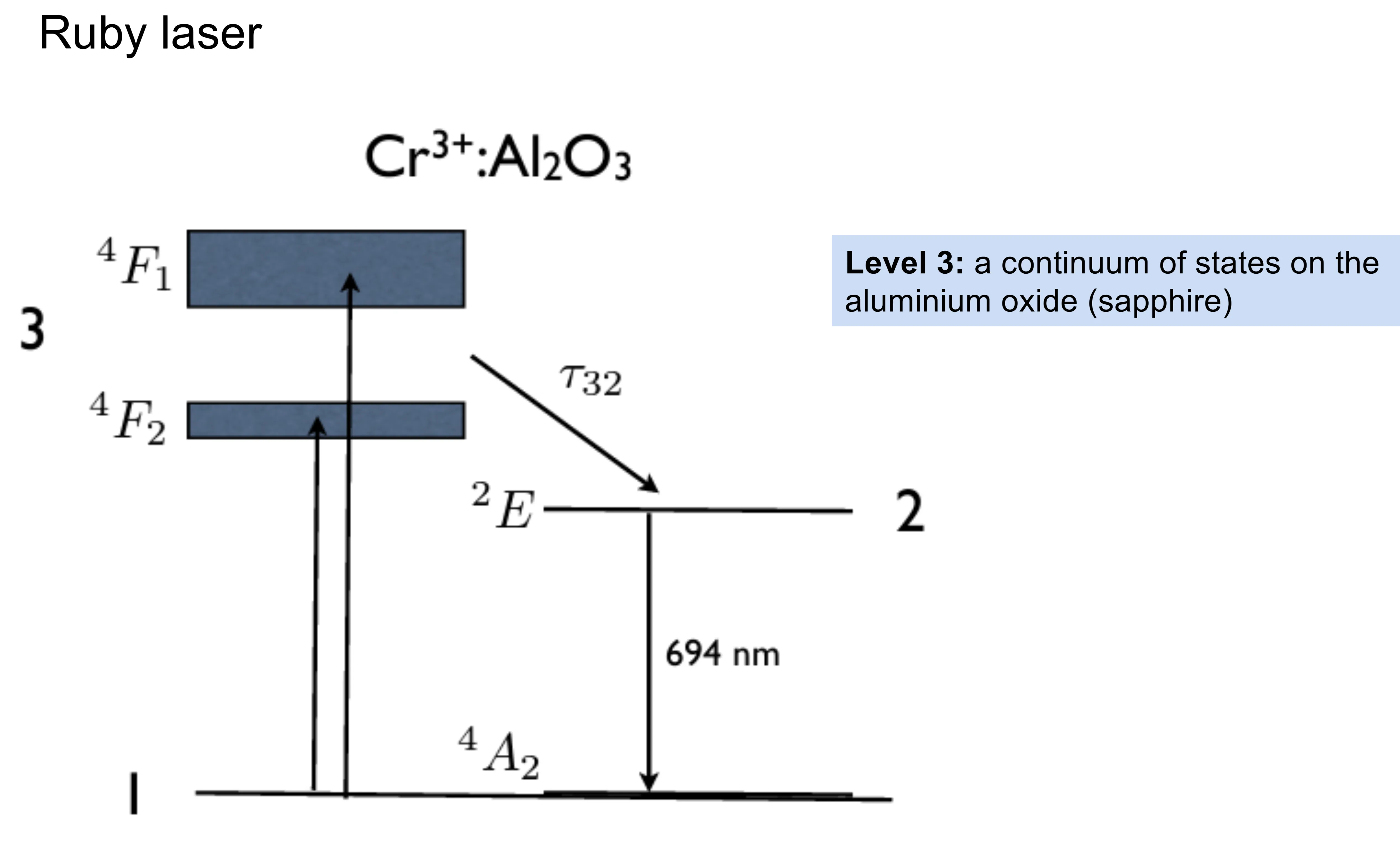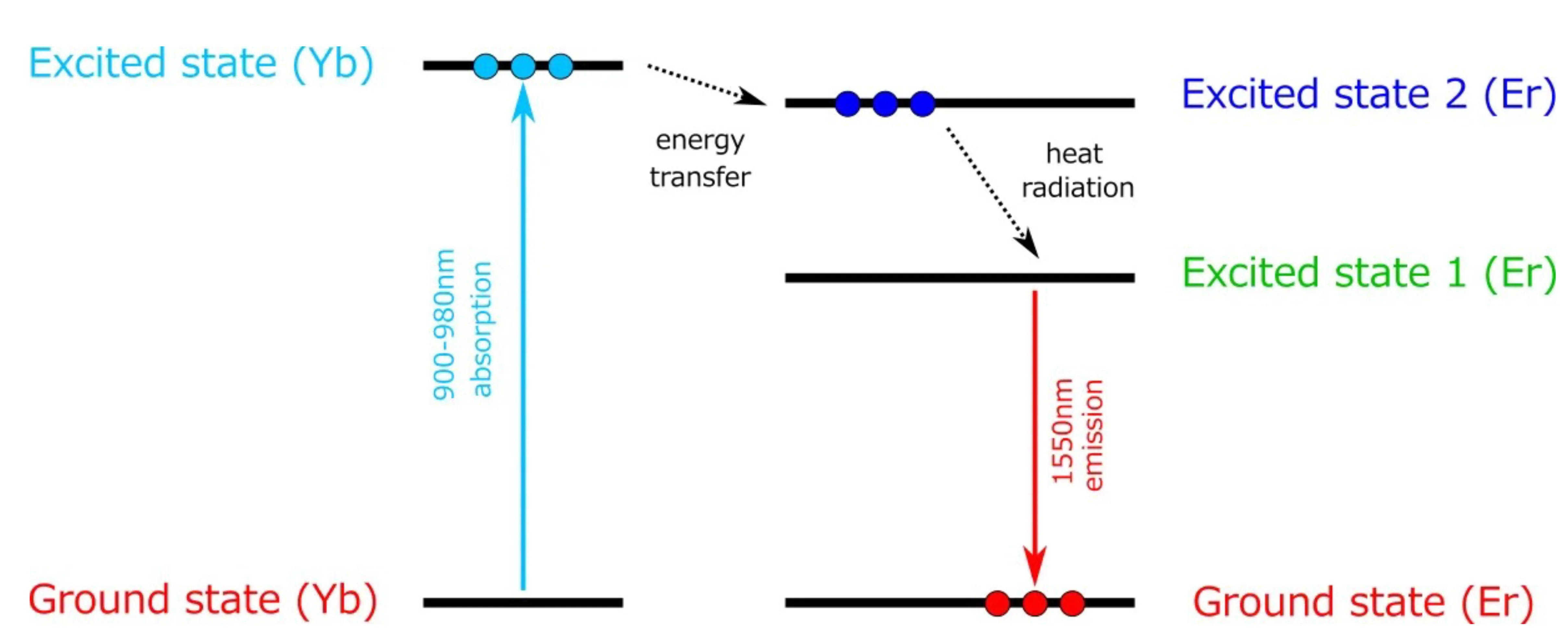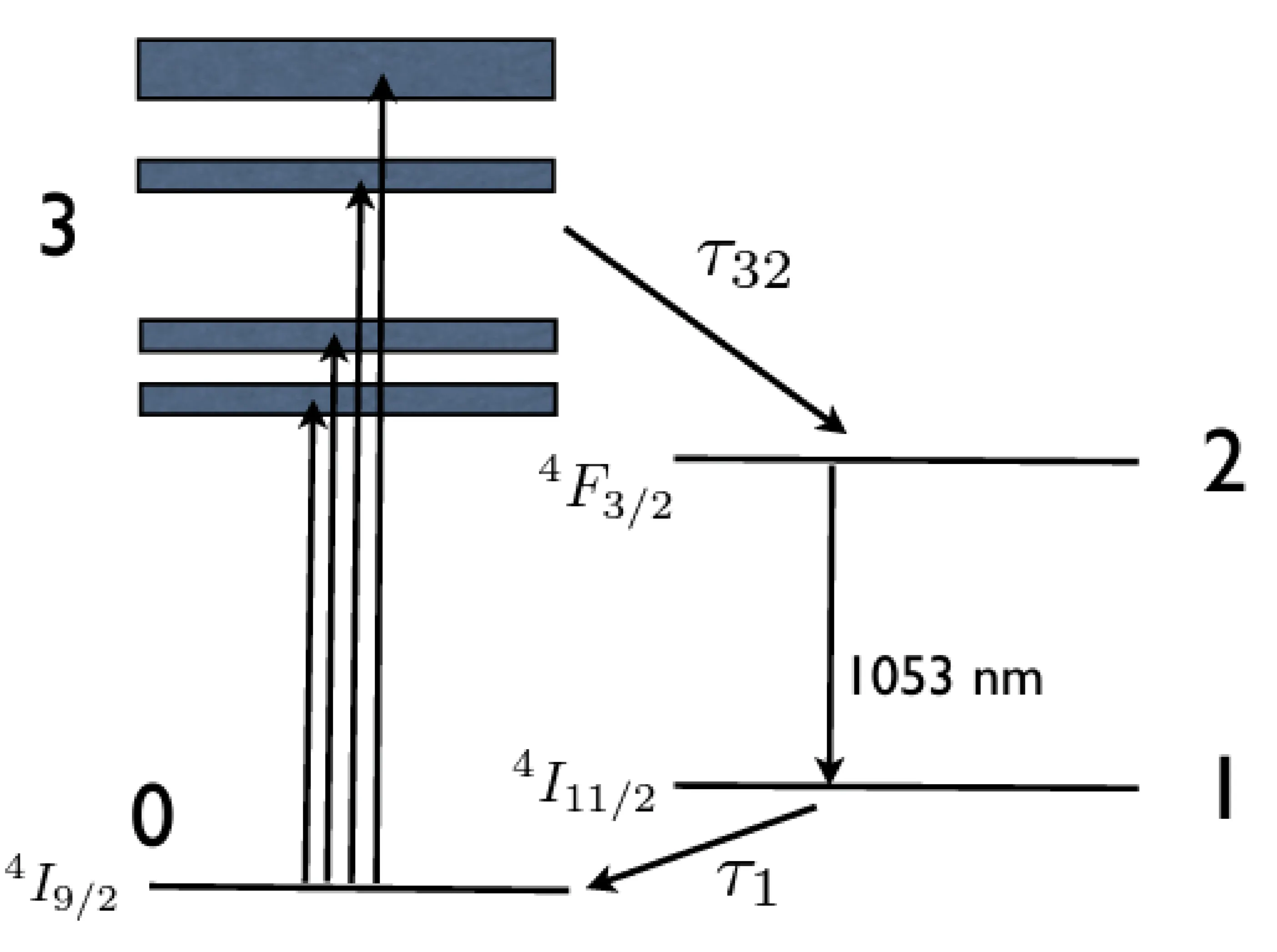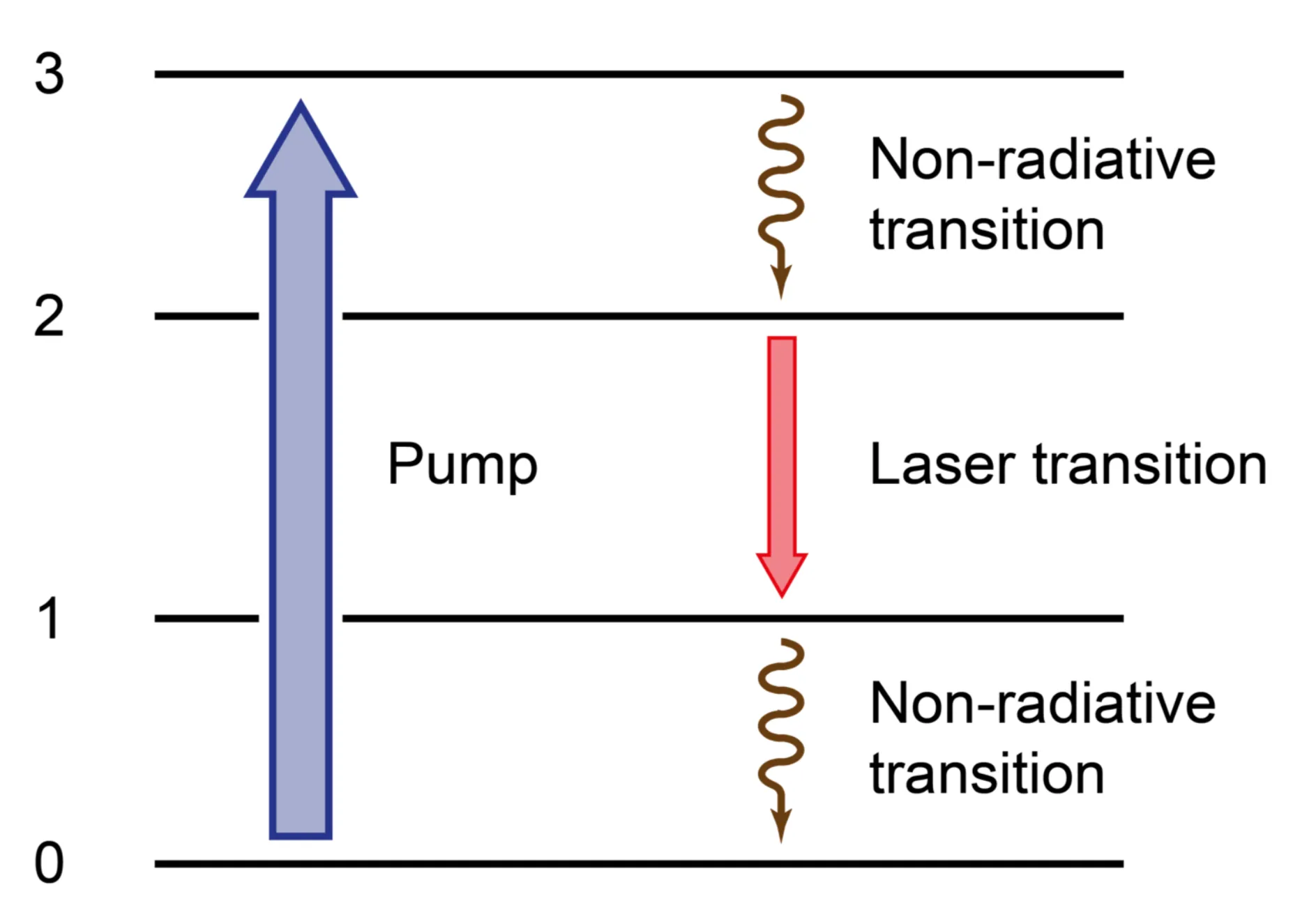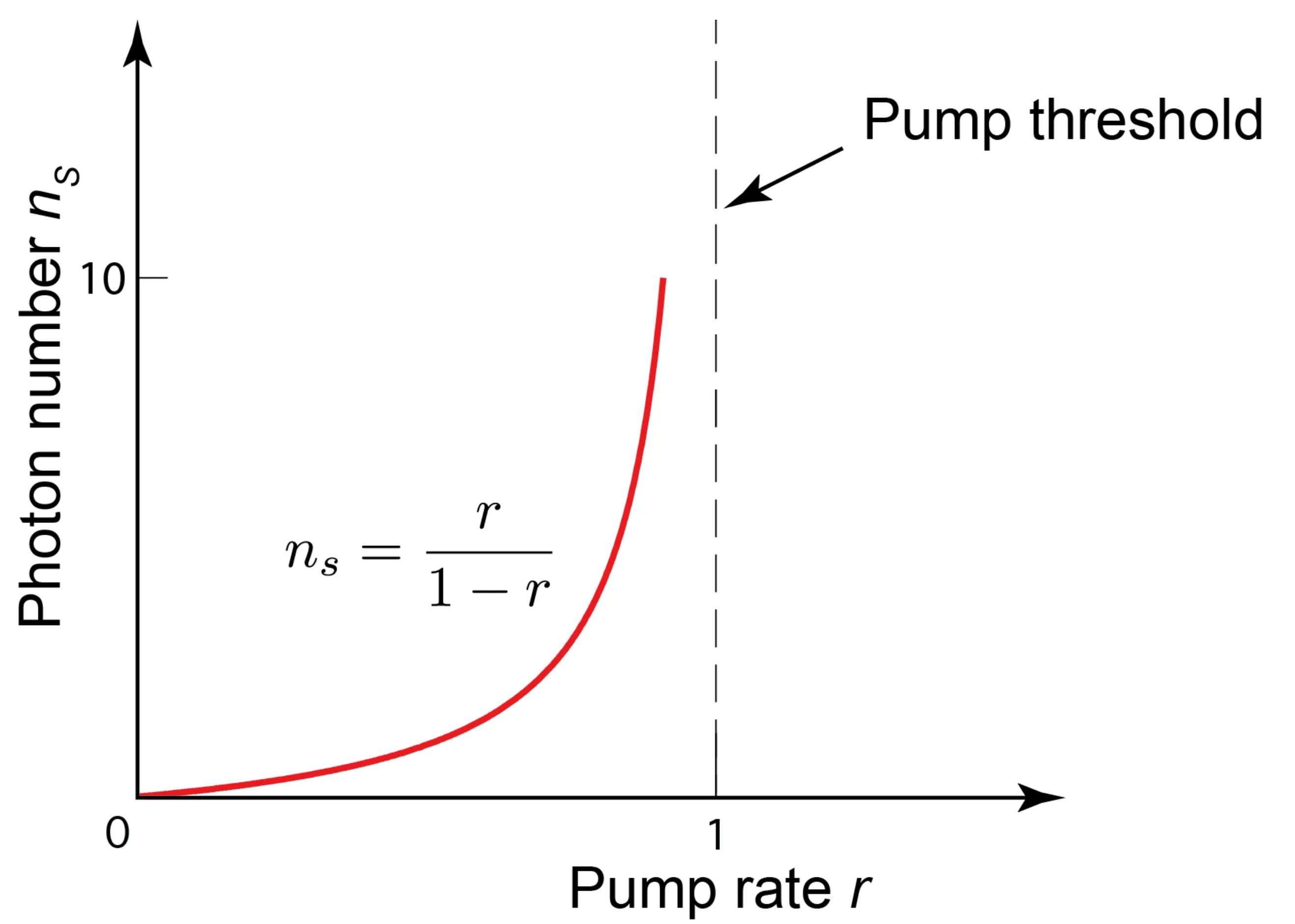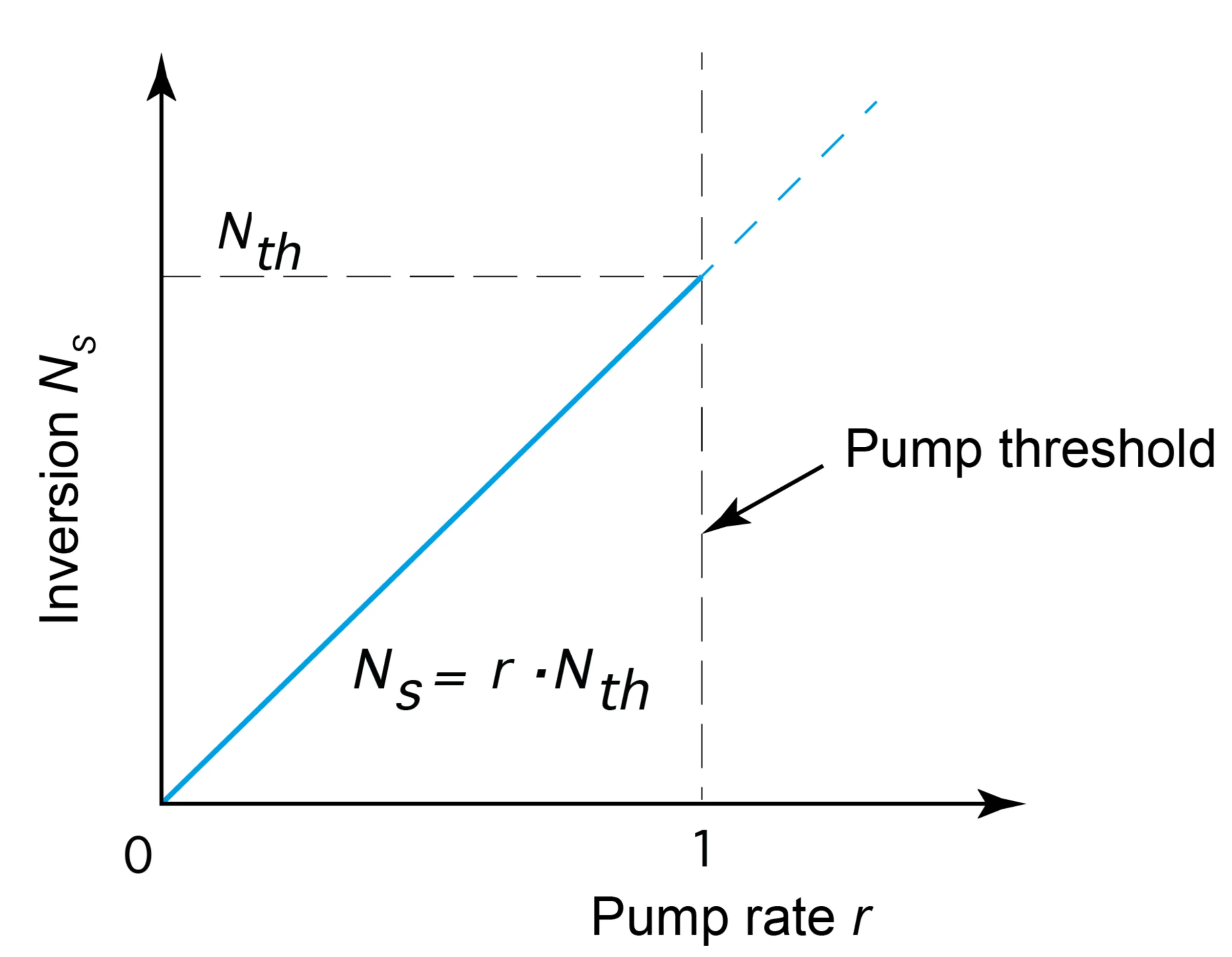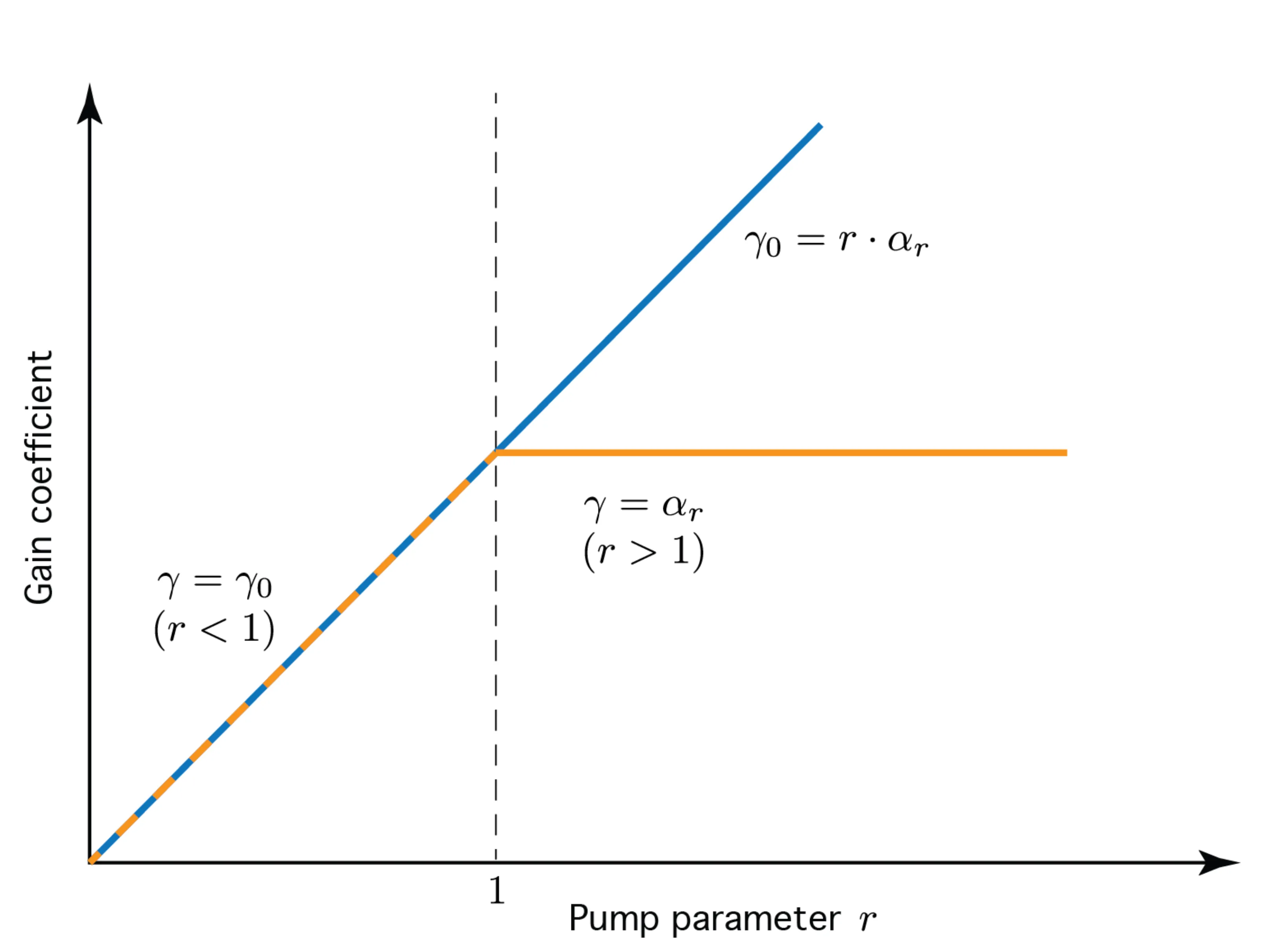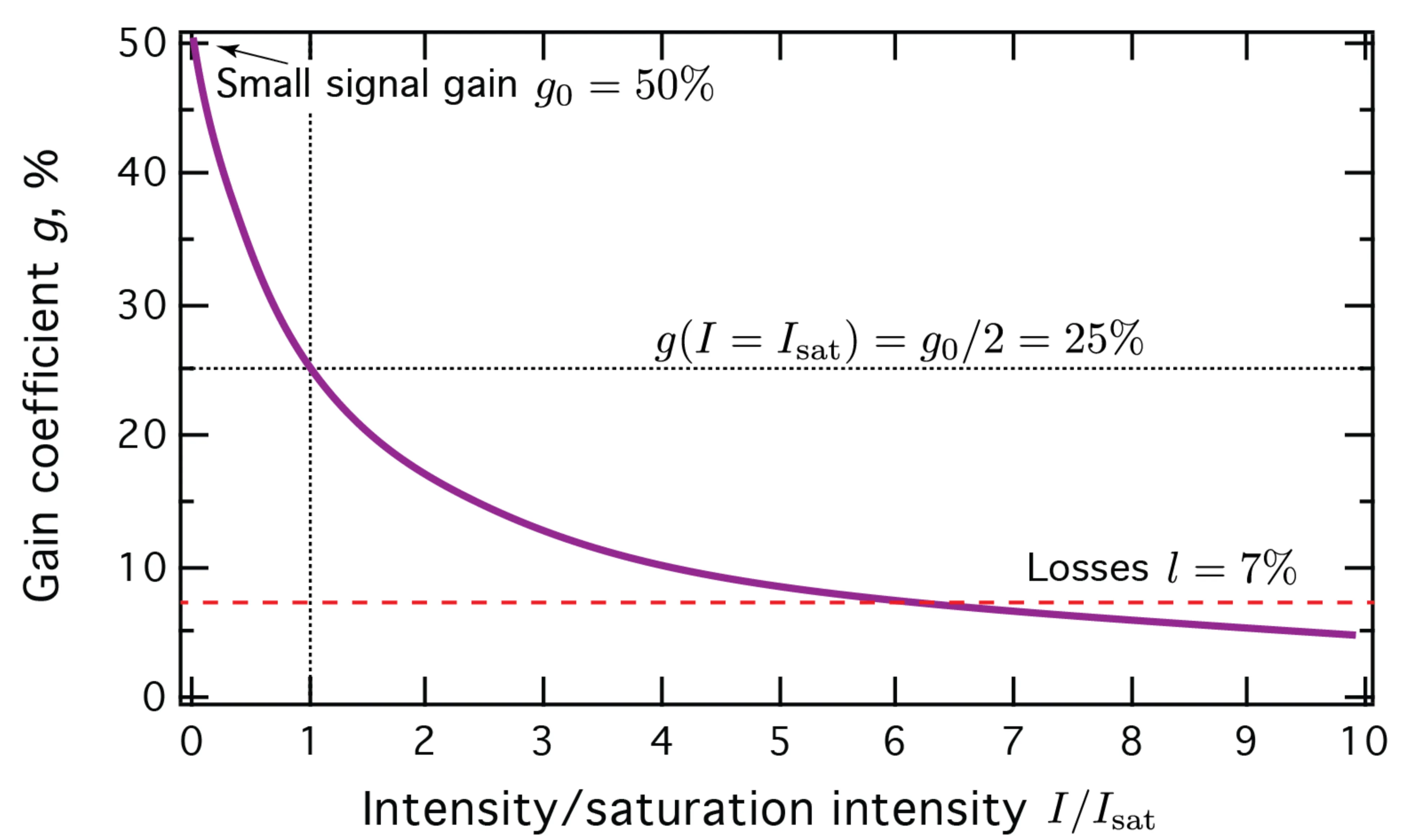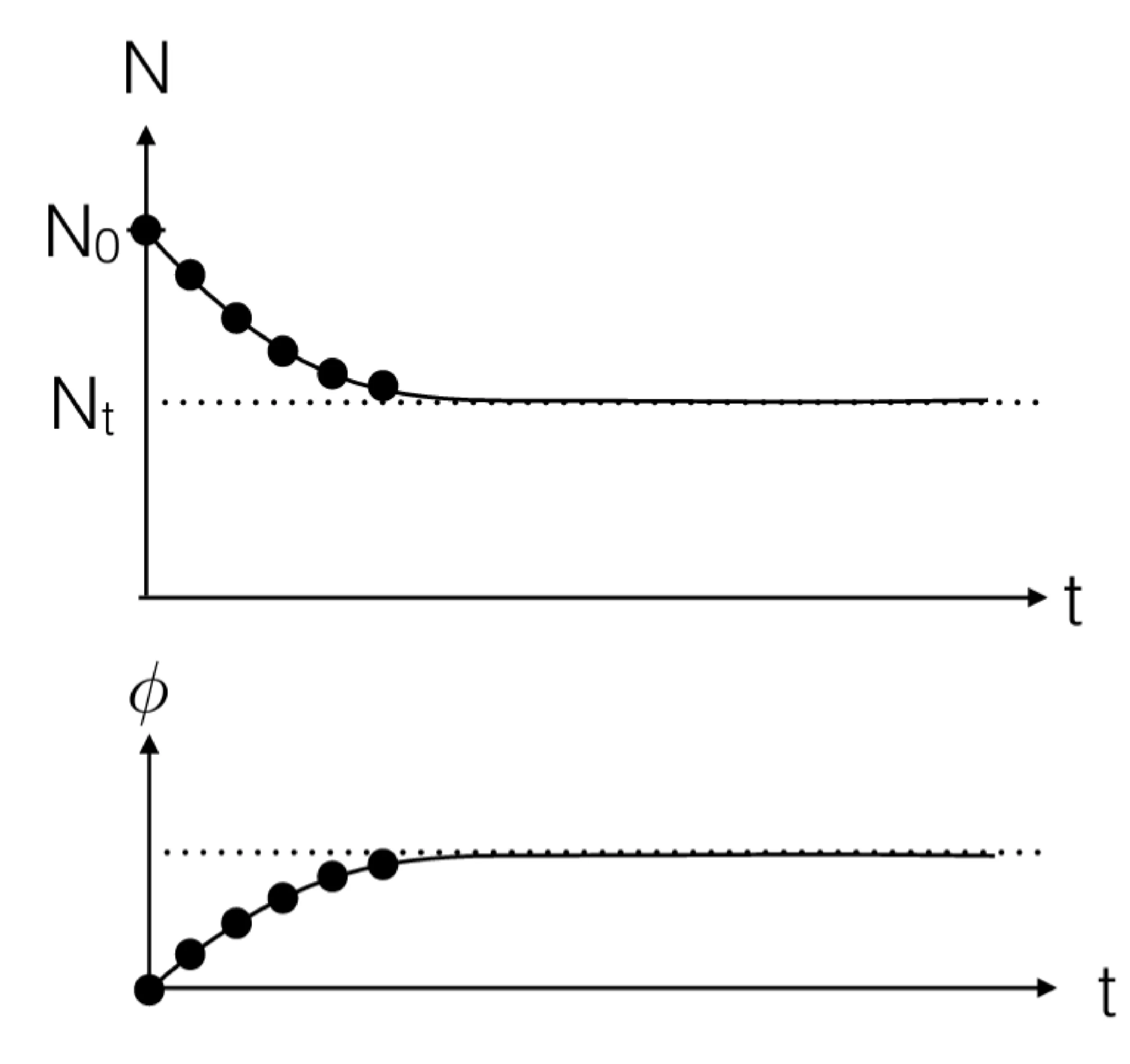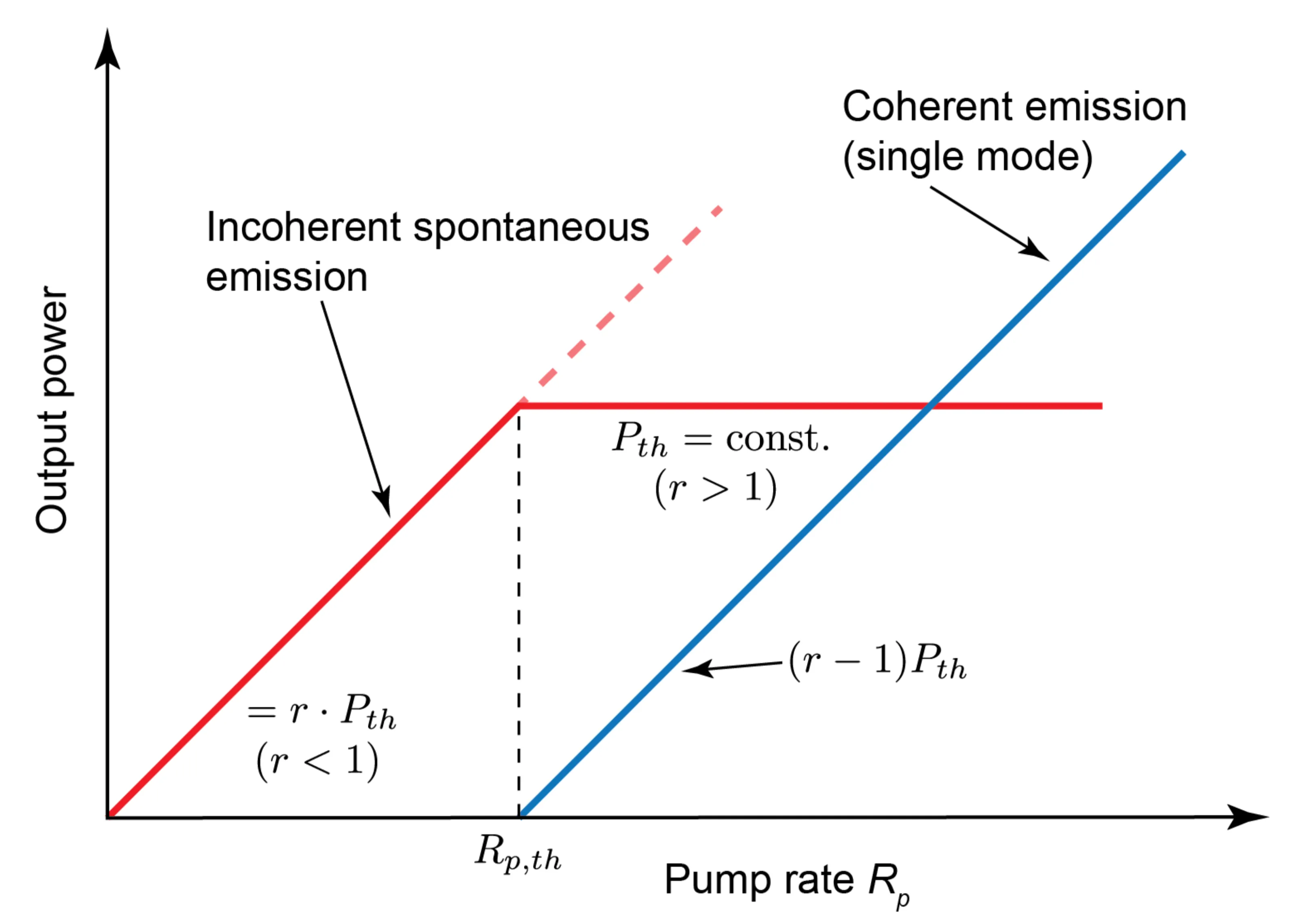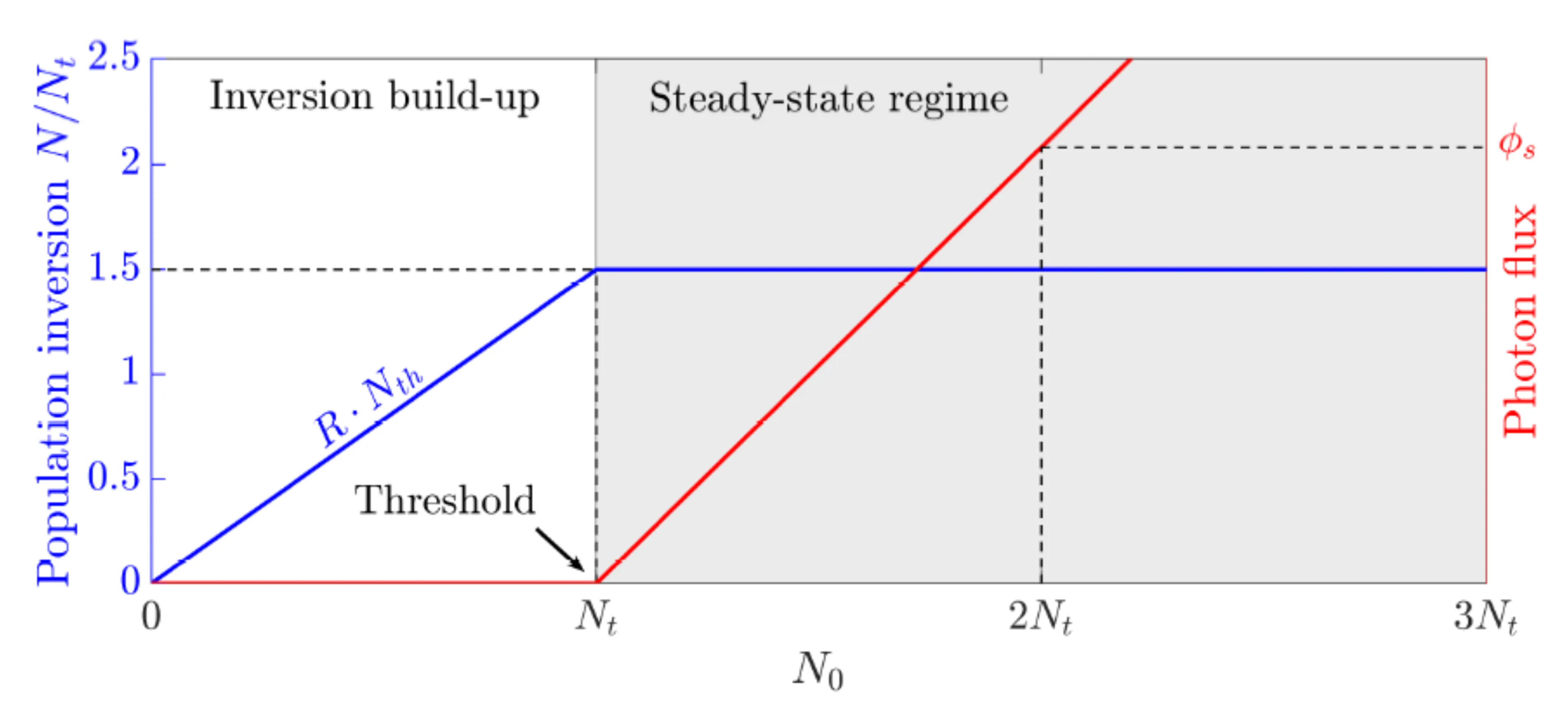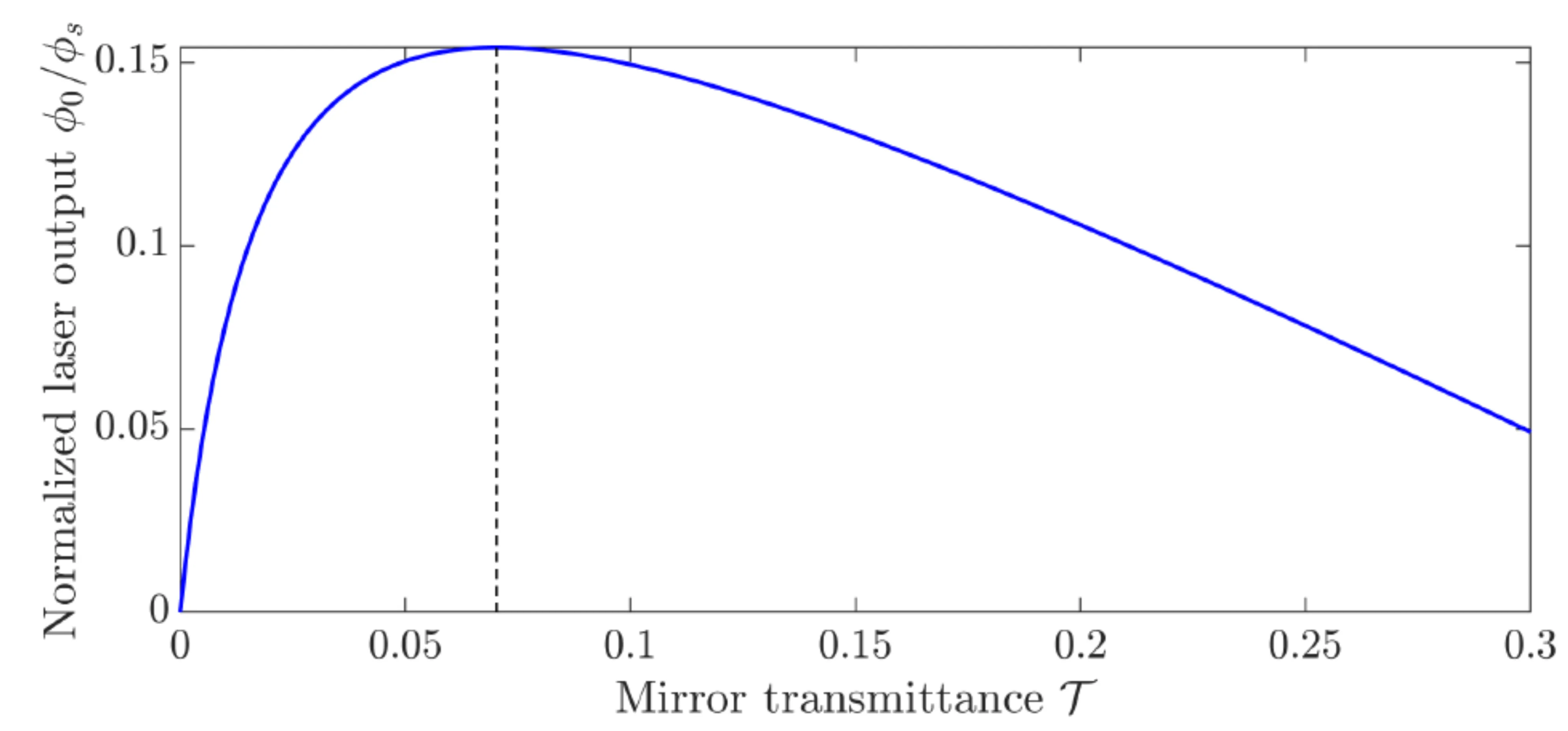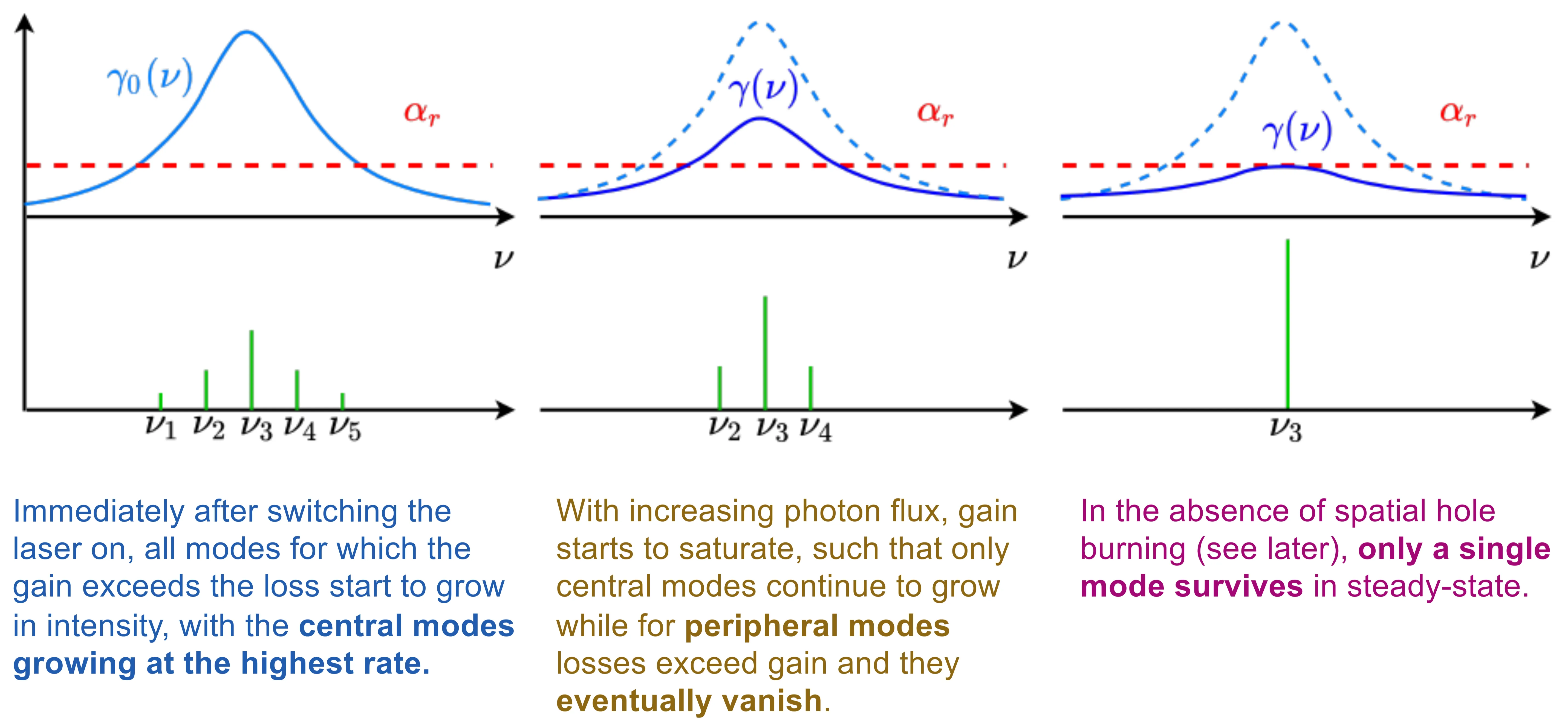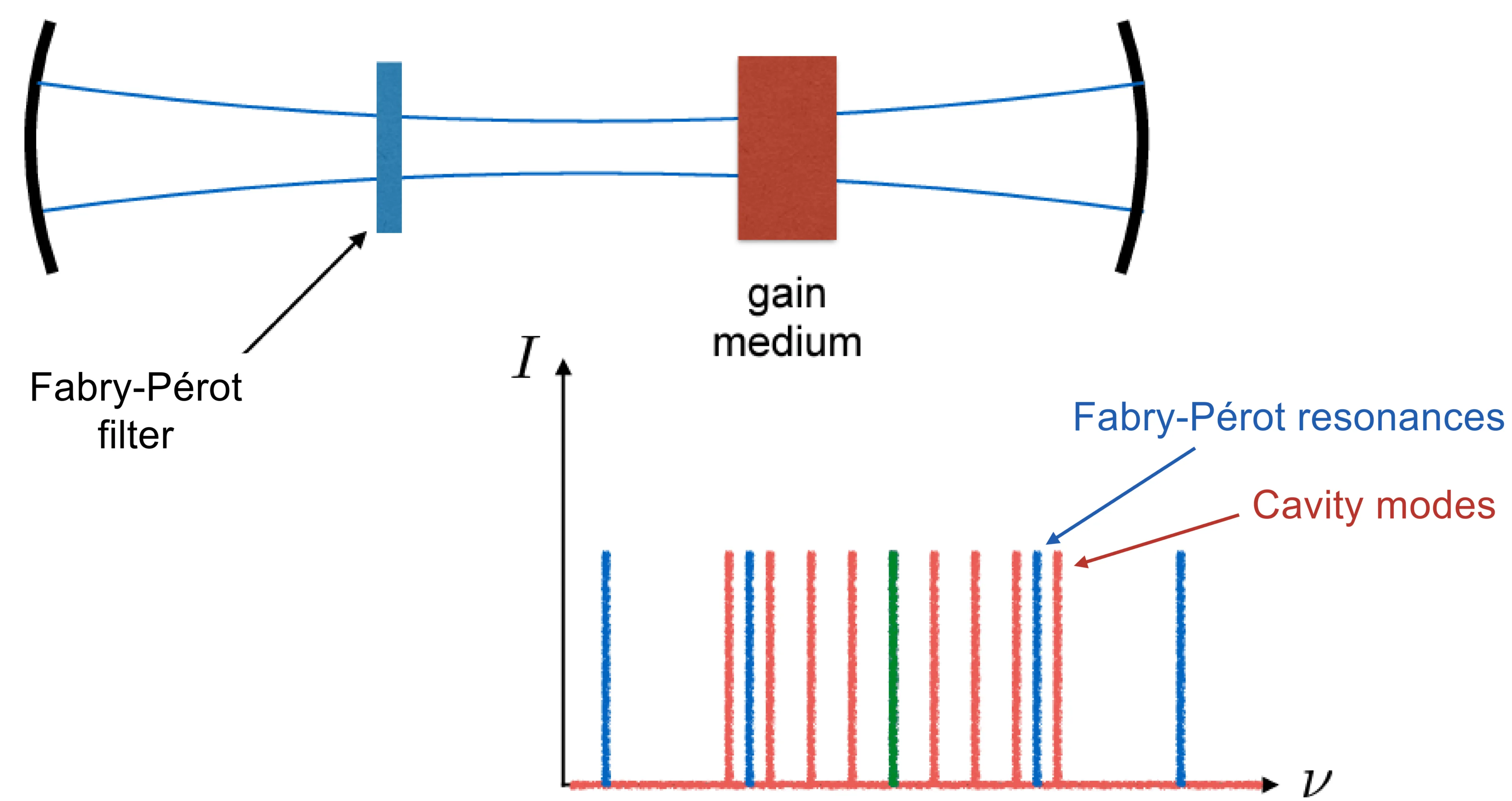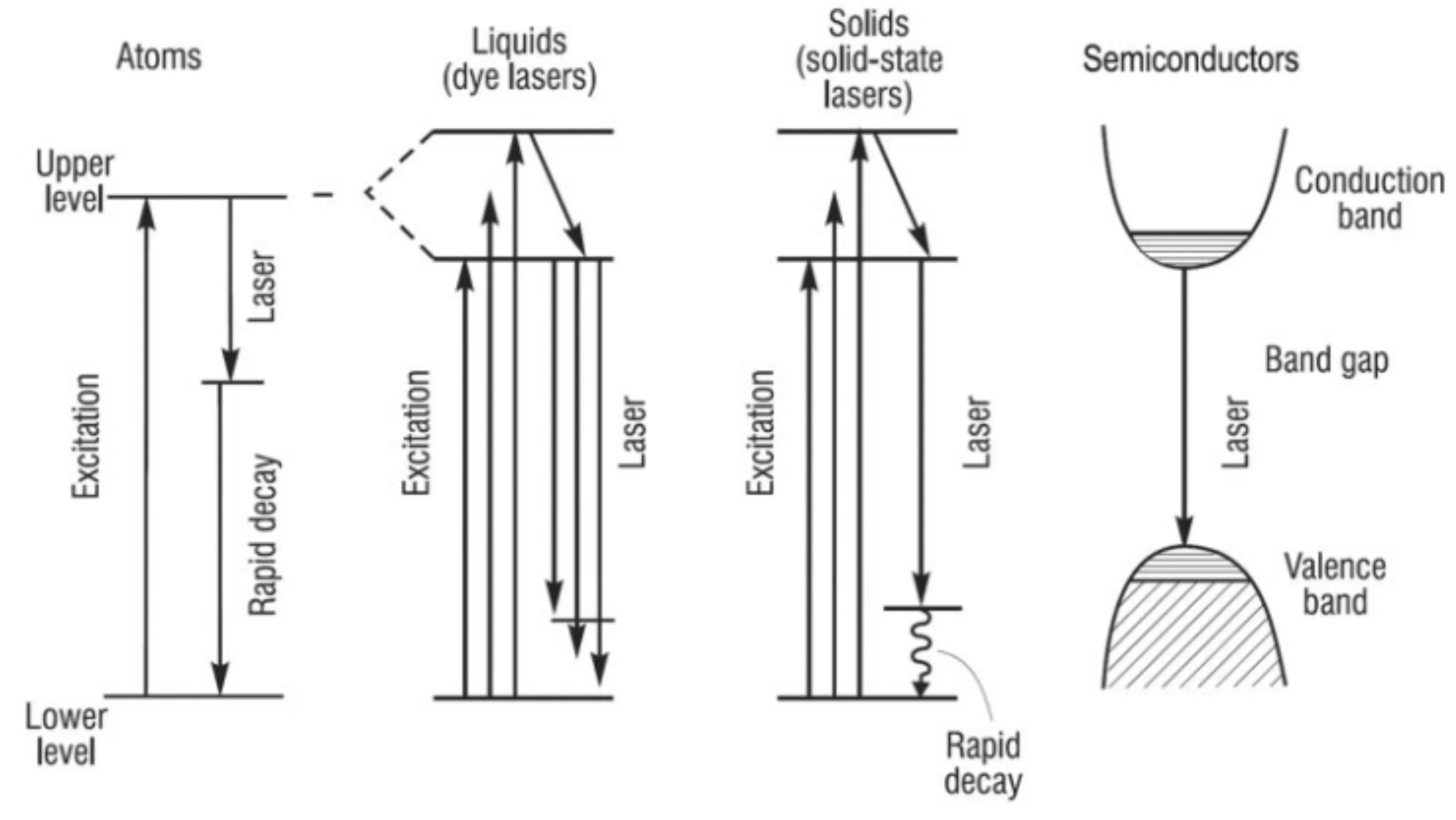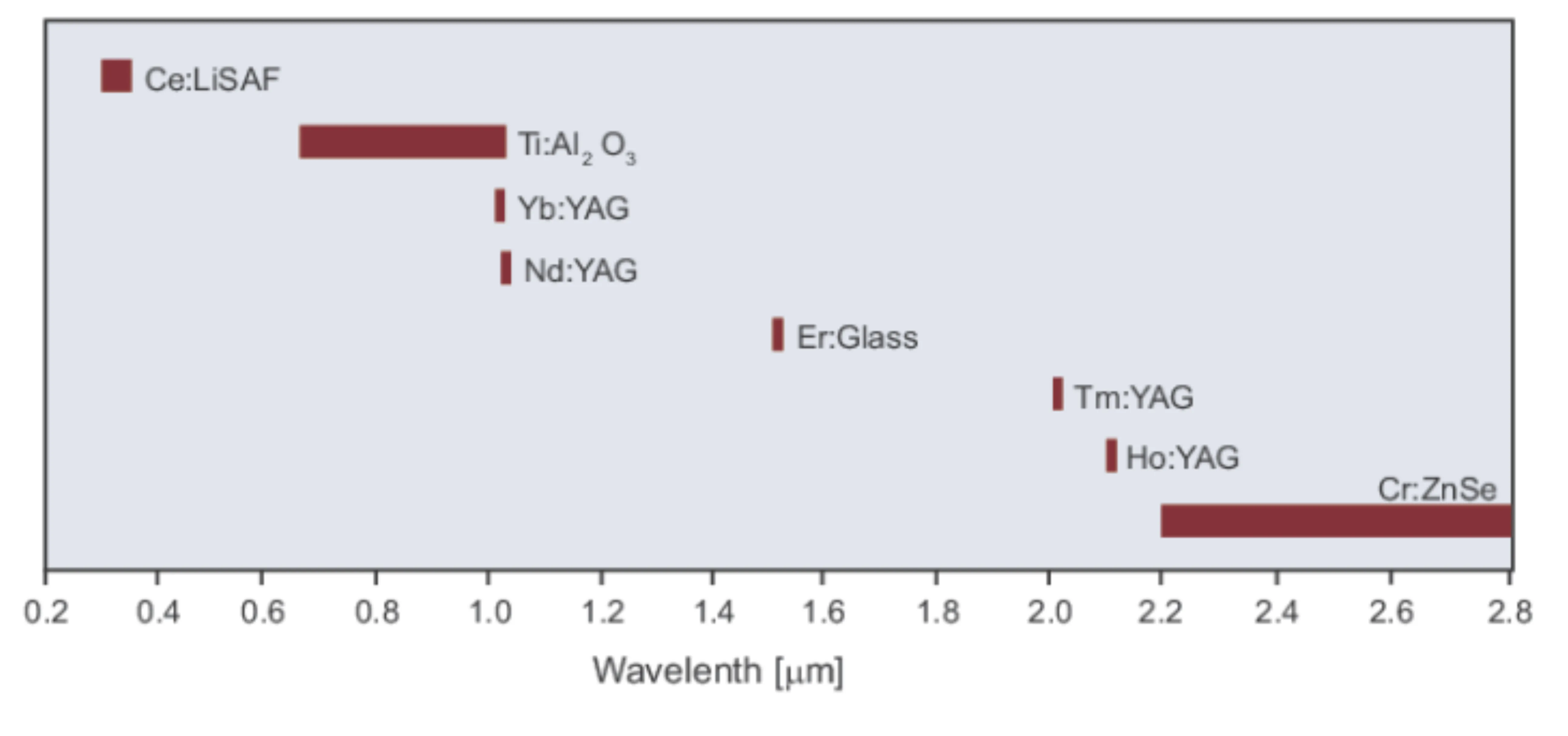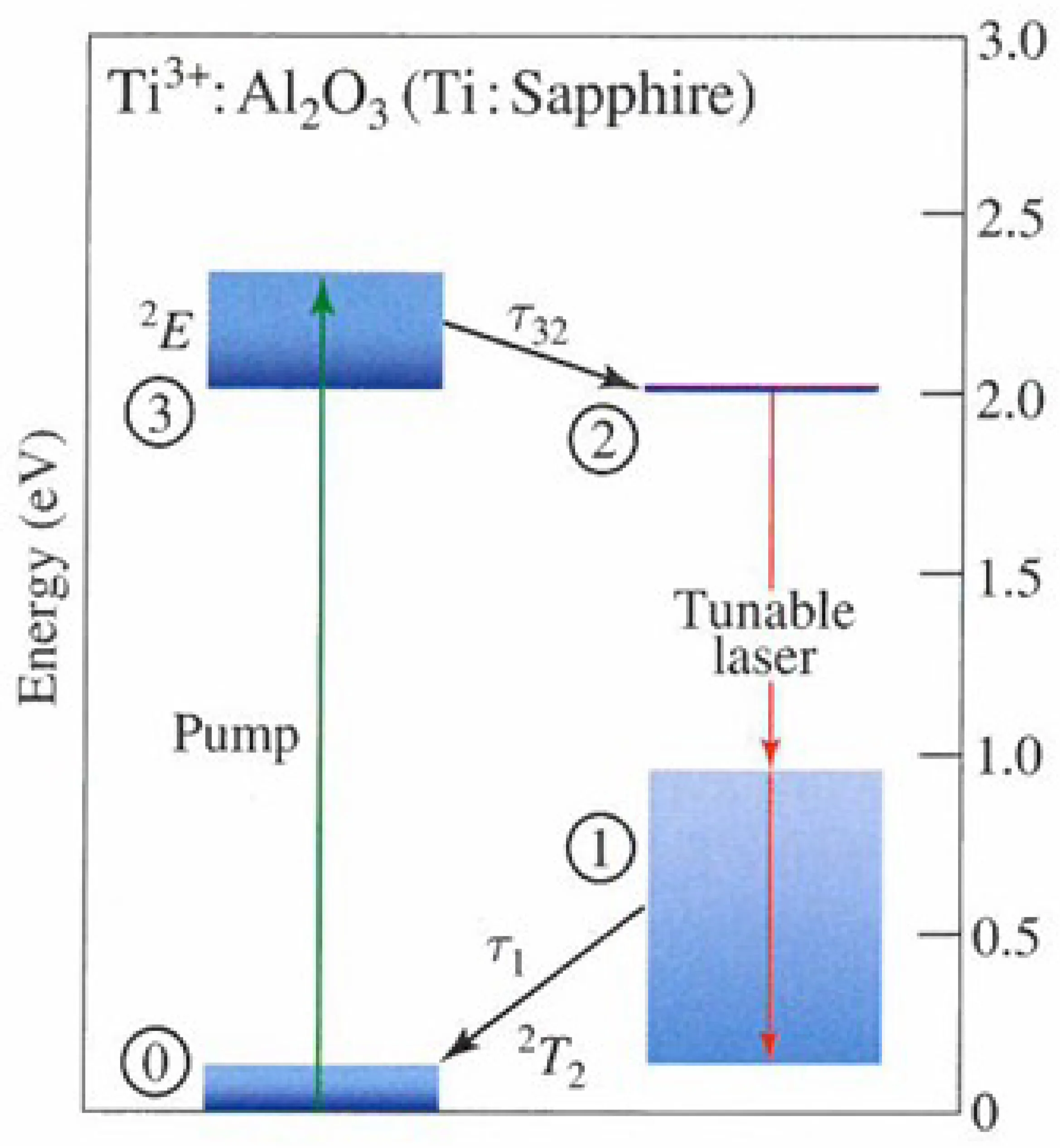Jump back to chapter selection.
Table of Contents
8.1 Fundamental Light-Matter Interaction
8.2 Einstein Coefficients and Rate Equation
8.3 Lasers
8.4 Laser Rate Equations
8.5 Experimental Parameters of Lasers
8.6 Initial Laser Dynamics
8.7 Mode Selection
8.8 Hole Burning
8.9 Pulsed Lasers - Overview
8.10 Examples of Lasers
8 Laser Fundamentals
In this chapter, the fundamental principles underlying the physics of a laser are discussed. However, before delving into the physics, let us understand what 'Laser' stands for:
Later on, we will understand why each word in this acronym plays a crucial role for these devices to function. A laser requires, at a very basic level, an amplifying medium (called the gain medium), a feedback mechanism (typically an optical resonator), and an energy source (called the pump). For now, we will consider a laser as an optical resonator system capable of emitting coherent light. We will discuss this in more detail in section 8.3. The following figure sketches the minimum requirements that a laser needs to have, as already mentioned:
In the following section, we will first introduce Einstein coefficients and deduce from these the requirements for the gain medium.
8.1 Fundamental Light-Matter Interaction
This section aims to give a brief overview of light-matter (or photon-atom) interactions that are relevant to understanding lasers. A full treatment of this topic requires quantum electrodynamics (QED), which goes much beyond the scope of this course. First, let us consider a quantum-mechanical material, that is, a material with quantised energy levels. To keep it simple, imagine a two-level system, comprising a ground state
In the following, we will assume that all these processes occur effectively instantaneously relative to other timescales of interest:
- a) Spontaneous emission: This process is independent of the presence of other photons. An atom or molecule in an excited state
may spontaneously transition to the ground state , releasing its excess energy as a photon with energy . The probability per unit time (rate) of this process for a single atom is denoted . - b) Absorption: An incoming photon of energy
can be absorbed by an atom in the ground state , exciting it to state . The probability per unit time of this process, , is proportional to the energy density of incident photons at frequency . If is the number of incident photons (or related to field intensity), the rate is proportional to . - c) Stimulated emission: An incoming photon with energy
can interact with an atom already in the excited state . This interaction can stimulate the atom to transition back to the ground state , emitting a second photon. This emitted photon is identical to the incident (stimulating) photon – it has the same frequency, phase, direction of propagation, and polarisation. This property is critical for light amplification. As with absorption, the probability per unit time of stimulated emission, , is proportional to the energy density of incident photons at frequency .
From these points, it should be clear that the rates for absorption and stimulated emission are not constant intrinsic atomic properties alone but depend on the strength of the incident electromagnetic field (related to
8.2 Einstein Coefficients and Rate Equation
Keeping the notation from above,
The lifetime
Similarly, we can define the absorption rate per atom,
Here,
Consider a collection of two-level atoms inside an optical cavity, with both the atoms and the electromagnetic field inside the cavity in mutual thermal equilibrium at temperature
where
The rate of change of
For population densities
In thermal equilibrium,
Solving for
Substituting
This expression for
(where
Comparing these two expressions for
If
This allows relating the probabilities (rates per atom per unit energy density) for absorption and stimulated emission to the probability (rate per atom) for spontaneous emission. The derivation also shows a fundamental symmetry between stimulated emission and absorption (
Although derived assuming thermal equilibrium, these relations between
8.2.1 Transition Width
The energy difference between two states is
Real transitions always have a finite width in energy (and thus frequency). This broadening occurs even with an ideal spectrometer possessing arbitrarily high spectral resolution. Several physical effects contribute to this broadening.
8.2.2 Homogeneous vs Inhomogeneous Broadening
Homogeneous broadening occurs when the broadening mechanism affects all atoms (or molecules) in the ensemble in an identical way. Each atom effectively has the same resonance frequency and the same broadened lineshape.
Examples include:
- Lifetime broadening (Natural broadening): Arises from the finite lifetime
of the excited state due to spontaneous emission, dictated by the energy-time uncertainty principle ( ). - Collision broadening (Pressure broadening): Collisions between atoms interrupt the emission process, effectively shortening the coherence time of the emitted radiation. In a dense gas or liquid, all atoms experience similar average collision rates.
Inhomogeneous broadening occurs when different atoms in the ensemble experience slightly different local environments or conditions, leading to a distribution of individual resonance frequencies. The overall observed spectral line is the sum of many narrower lines, each slightly shifted.
An important example is Doppler broadening in gases, where atoms moving with different velocities relative to an observer (or a detector) exhibit different apparent transition frequencies due to the Doppler effect. Another example is broadening in solids due to variations in the local crystal field experienced by different active ions.
Let us consider lifetime broadening again. The intensity of light
(The factor of
Fourier transforming this decaying sinusoidal field yields a spectral intensity profile
where
This corresponds to an ensemble of atoms where each atom emits light with this characteristic spectral profile. The normalised lineshape function
Its general properties are
In contrast, if a Doppler broadened spectrum consists of a statistical distribution of individual, shifted (but perhaps still lifetime-broadened) Lorentzian spectra, the overall observed lineshape for inhomogeneous broadening is often Gaussian.
8.2.3 Absorption Cross-Section
The absorption cross-section
The absorption cross-section
where
8.3 Lasers
Let us now return to achieving a functioning laser. For simplicity, we will consider a laser cavity designed to amplify light primarily in a small number of resonant modes:
8.3.1 Population Inversion, Lasing Conditions and Gain
The ultimate goal of a laser is to increase the photon number
Using Einstein coefficients, this can be written as (ignoring cavity losses for now):
where
For net amplification by stimulated emission, we need
Using
This condition,
Another requirement for lasing is feedback. To ensure that stimulated emission dominates spontaneous emission and to build up a substantial photon number in a specific mode, the emitted photons must be confined and made to pass through the gain medium multiple times. This is achieved by placing the gain medium within an optical resonator (cavity), typically formed by two mirrors. The resonator selectively enhances specific frequencies (its resonant modes) and provides the feedback, greatly increasing
The notion of gain quantifies the amplification. If a photon flux
Here,
The total gain
Thus, schematically a laser involves pumping to achieve population inversion in a gain medium, which is placed inside an optical resonator to provide feedback and mode selection:
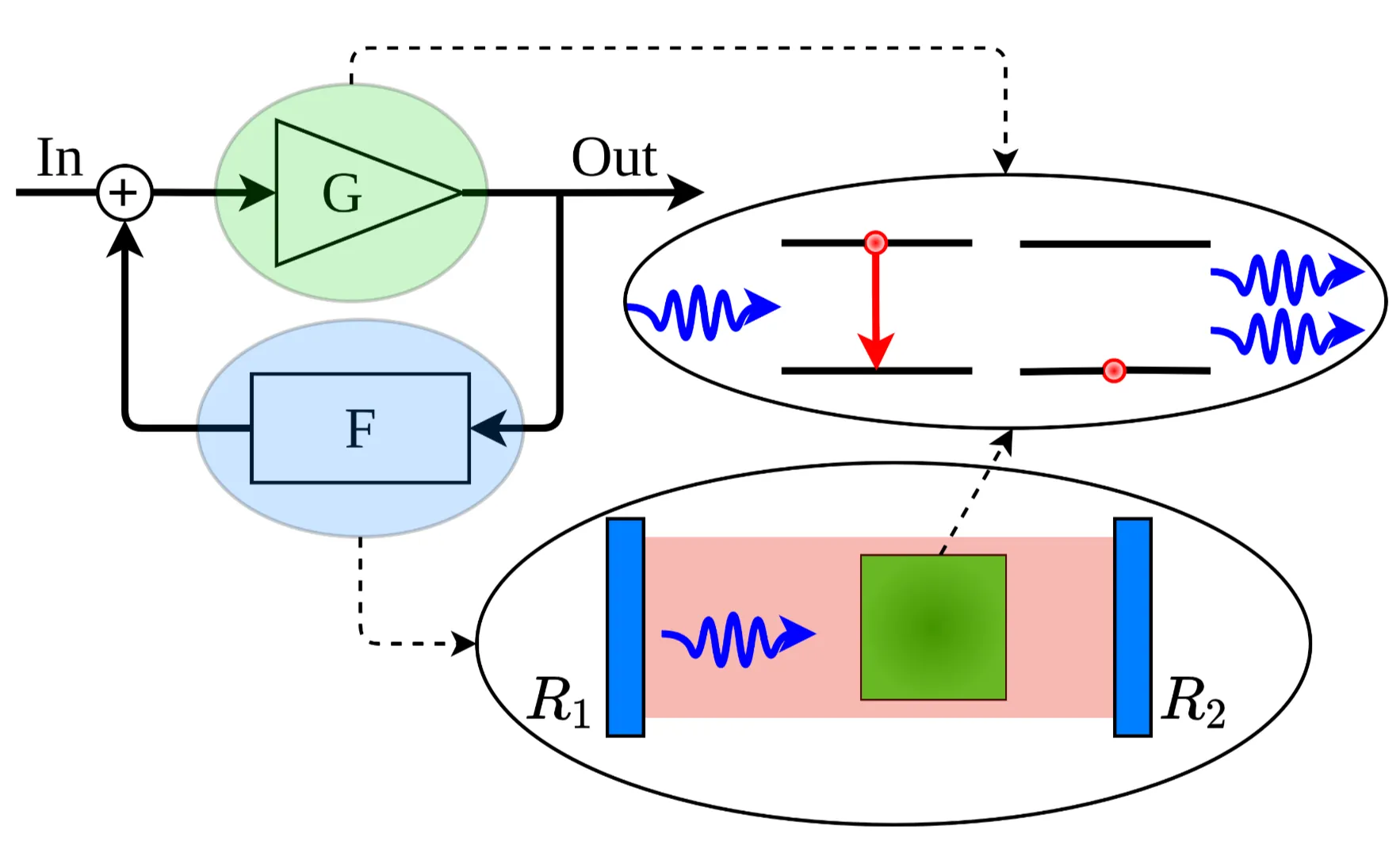
The feedback also provides narrow spectral filtering due to the cavity resonances.
8.3.2 Achieving Population Inversion
As mentioned, pumping the system from state
The small-signal gain coefficient
8.3.3 Three-Level Laser Systems
Since population inversion is unobtainable in an ideal two-level system pumped on the lasing transition, we consider systems with more levels. A three-level system is the minimum required for achieving inversion.
The general layout is:
Atoms are pumped from the ground state
The rate equations (assuming
where
Solving for steady-state (
Achieving inversion (
The first laser, the ruby laser (
Erbium-doped silica fibre amplifiers/lasers can also operate on a quasi-three-level scheme depending on the wavelength.
Ytterbium-doped YAG (
8.3.4 Four-Level System
The challenges of high pump thresholds in three-level systems are largely overcome in a four-level system:
Here, atoms are pumped from the ground state
This rapid depopulation of the lower laser level
The rate equations simplify under these assumptions (
One example of a four-level laser system is Nd:YAG or Nd:glass (neodymium-doped YAG crystal or glass), widely used in high-power applications.
8.3.5 Pumping Schemes
A variety of pumping schemes are used to deliver energy to the gain medium. Some examples include:
- (a) Gas laser pumped by direct current (DC) electrical discharge.
- (b) Solid-state laser pumped by a flashlamp.
- (c)
solid-state laser optically pumped by a laser diode array. - (d) Fibre laser (such as erbium-doped silica fibre) with fibre Bragg grating reflectors, pumped with a laser diode.
- (e) Laser diode (a forward-biased p-n junction) with cleaved facets acting as mirrors, pumped by electrical current injection.
- (f) Quantum-well semiconductor laser, pumped electrically.
8.4 Laser Rate Equations
We will treat an ideal four-level system in more detail. Assume an ideal system where
Consider a single lasing mode within the cavity, and assume a homogeneously broadened gain medium. Let
where:
is a coupling constant proportional to the stimulated emission cross-section and mode volume ( ). is the rate of spontaneous emission into the lasing mode (the "+1" in from some texts is written as here, as spontaneous emission into the mode). is the rate of stimulated emission into the lasing mode. is the cavity photon decay rate (loss rate from cavity, , where is photon lifetime). is the pumping rate into the upper laser level . is the total decay rate of the upper laser level due to all processes other than stimulated emission into the lasing mode (primarily spontaneous emission, ).
In stationary solutions (
From the first equation (for
This implies
This defines the threshold inversion density:
Above threshold, the inversion clamps at
From the second equation,
The threshold pumping rate
Let
Then
- Above threshold (
): The inversion is clamped to its threshold value. Every additionally pumped atom primarily contributes to stimulated emission, increasing the coherent photon number . - Below threshold (
):
Stimulated emission is negligible (). .
The photon numberis very small, dominated by spontaneous emission into the mode: .
The output power is proportional to
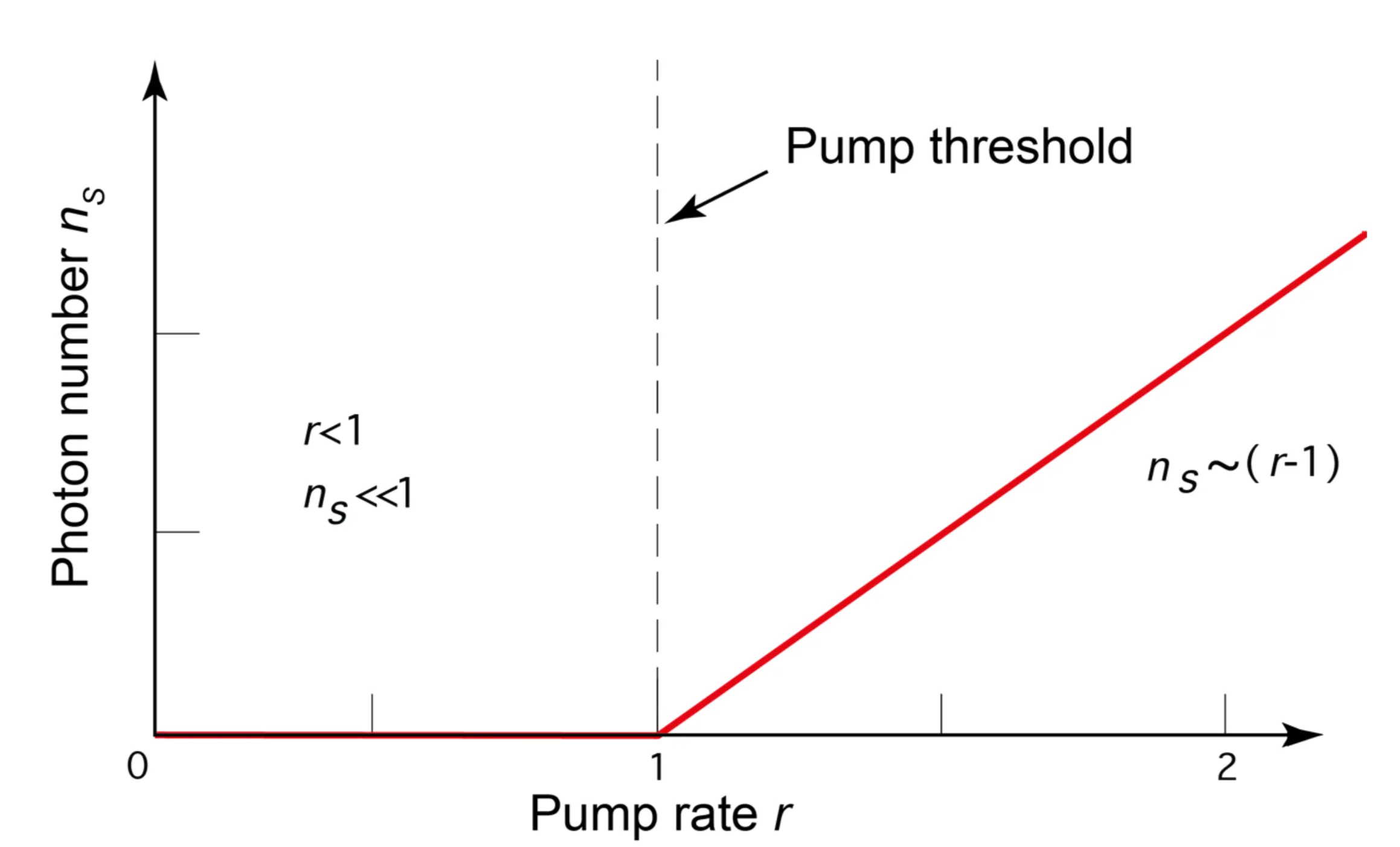

The exact solutions show a smooth transition around the threshold:
8.5 Experimental Parameters of Lasers
In practice, inversion and photon number are not always the most directly accessible experimental quantities. Gain, loss, and output power (related to photon flux) are often more useful.
The gain coefficient is
The small-signal gain coefficient (unsaturated gain) is
Gain clamping above threshold means
The resonator losses
After one resonator round trip of length
The total round trip gain (power) is
The net gain per round trip
Thus,
The gain coefficient saturates with increasing intra-cavity intensity
where
Both saturation intensity and fluence are material and transition-specific properties.
Gain clamping:
The small-signal gain
8.6 Initial Laser Dynamics
Initially, when pumping starts, the photon flux in the cavity is negligible (originating from spontaneous emission). The population inversion
Initially, there is primarily incoherent spontaneous emission. As lasing threshold is reached and surpassed, coherent stimulated emission into one or a few cavity modes dominates. The total spontaneous emission into all
Above threshold, pumping harder primarily increases the flux of coherent photons, while the population inversion (and thus gain) remains clamped at the threshold value
To optimise the laser output power
Another useful form for the threshold inversion density is:
This shows that it is more difficult to reach threshold (higher
8.7 Mode Selection
So far, we have assumed that the energy emitted by an atomic transition is quantised, ideally leading to emitted light at a single frequency
Lasing will occur preferentially for those cavity modes that fall within the gain bandwidth
For some applications, single-longitudinal-mode operation is required. This can be achieved by introducing spectrally selective loss elements into the cavity (such as etalons or birefringent filters) to ensure only one desired mode remains above threshold. The following figures show some methods for longitudinal mode selection:
Selection of a single transverse mode (typically the fundamental
Mode selection also depends on the type of pumping scheme and how well the pumped volume in the gain medium overlaps with the desired lasing mode volume:
8.8 Hole Burning
There are two main types of hole burning relevant to lasers:
- Spatial hole burning: This occurs in linear laser resonators where a standing wave intensity pattern is formed by the counter-propagating waves. Gain saturation is strongest at the antinodes of this standing wave and weakest at the nodes. This means that near the standing wave minima, the gain is not effectively saturated by the lasing mode. Consequently, other longitudinal modes, whose standing wave patterns might have antinodes where the primary mode has nodes, can reach threshold and lase. This leads to multi-mode operation. Ring laser cavities, where light propagates in one direction, avoid the formation of strong standing waves and thus mitigate spatial hole burning.
- Spectral hole burning: This occurs predominantly in inhomogeneously broadened gain media. When a particular longitudinal mode starts lasing at frequency
, it primarily interacts with and saturates only those atoms (or molecules) whose individual resonance frequencies are close to . Once these atoms are saturated, they no longer contribute significantly to the gain at . This effectively "burns a hole" in the gain spectrum at that frequency, reducing the gain for that specific mode. Other modes at different frequencies, interacting with different sub-ensembles of atoms, might still be above threshold.
8.9 Pulsed Lasers - Overview
Previously, the discussion largely focused on continuous wave (CW) and single-mode lasers, which (ideally) have a constant intensity output as a function of time. Very often, however, pulsed laser operation is desired, as pulsed lasers are crucial for a wide range of applications. The average power of a laser is typically limited by thermal effects in the gain medium and pump source capabilities. A laser emitting short pulses essentially concentrates its energy into very brief intervals of light, which in turn leads to very high peak power and peak intensity, even if the average power is moderate. High peak power enables various nonlinear optical applications important for industrial processes and scientific research. Furthermore, short pulses allow for high time-resolution in measurements of dynamical processes, such as molecular vibrations or even electronic wavepacket motion. These measurements and techniques form the core of Ultrafast Laser Physics. The following is an overview of common methods to produce laser pulses.
- Gain Switching: This is perhaps the simplest technique to produce pulses of light. The pump source is rapidly turned on and off, effectively switching the gain above and below the threshold. The duration of the pulses achievable with this method is limited by several timescales, including the initial build-up time of photons in the cavity and the decay time after the gain is switched off, both of which depend on the gain medium and cavity properties. The speed of switching the pump (and thus the gain) also limits the pulse duration. This method is typically suitable for generating relatively long pulses, with durations of several microseconds or longer.
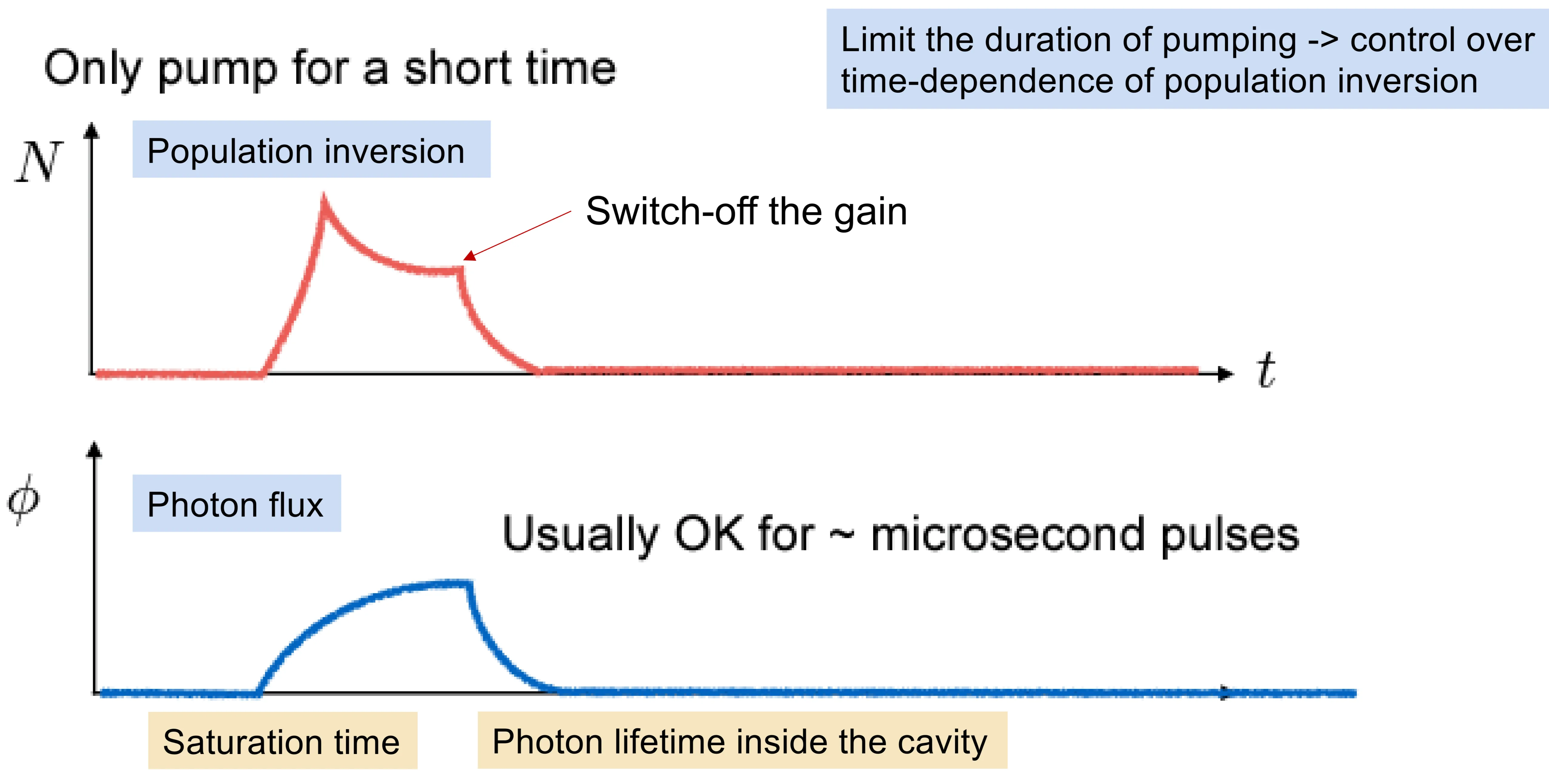
- Q-Switching: This method involves modulating the quality factor (Q-factor) of the laser cavity, which is inversely related to the cavity losses. Lasing requires gain to exceed losses. The idea is to initially keep the cavity losses very high (low Q), suppressing lasing, which allows the pump to build up a very large population inversion in the gain medium, far above the normal threshold level. At a chosen moment, the losses are suddenly reduced (Q is switched to a high value). With the gain now significantly exceeding the (lowered) losses, stimulated emission rapidly depopulates the inversion, releasing the stored energy as a short, intense pulse of light. This Q-switching can be achieved using active modulators (such as electro-optic or acousto-optic switches) or passive saturable absorbers. Compared to gain switching, the population inversion is already established at a high level before the pulse emits, allowing for shorter pulse durations and much higher peak powers. It is the method of choice for achieving pulses with large pulse energy (millijoules to joules). The duration is typically limited to nanoseconds.
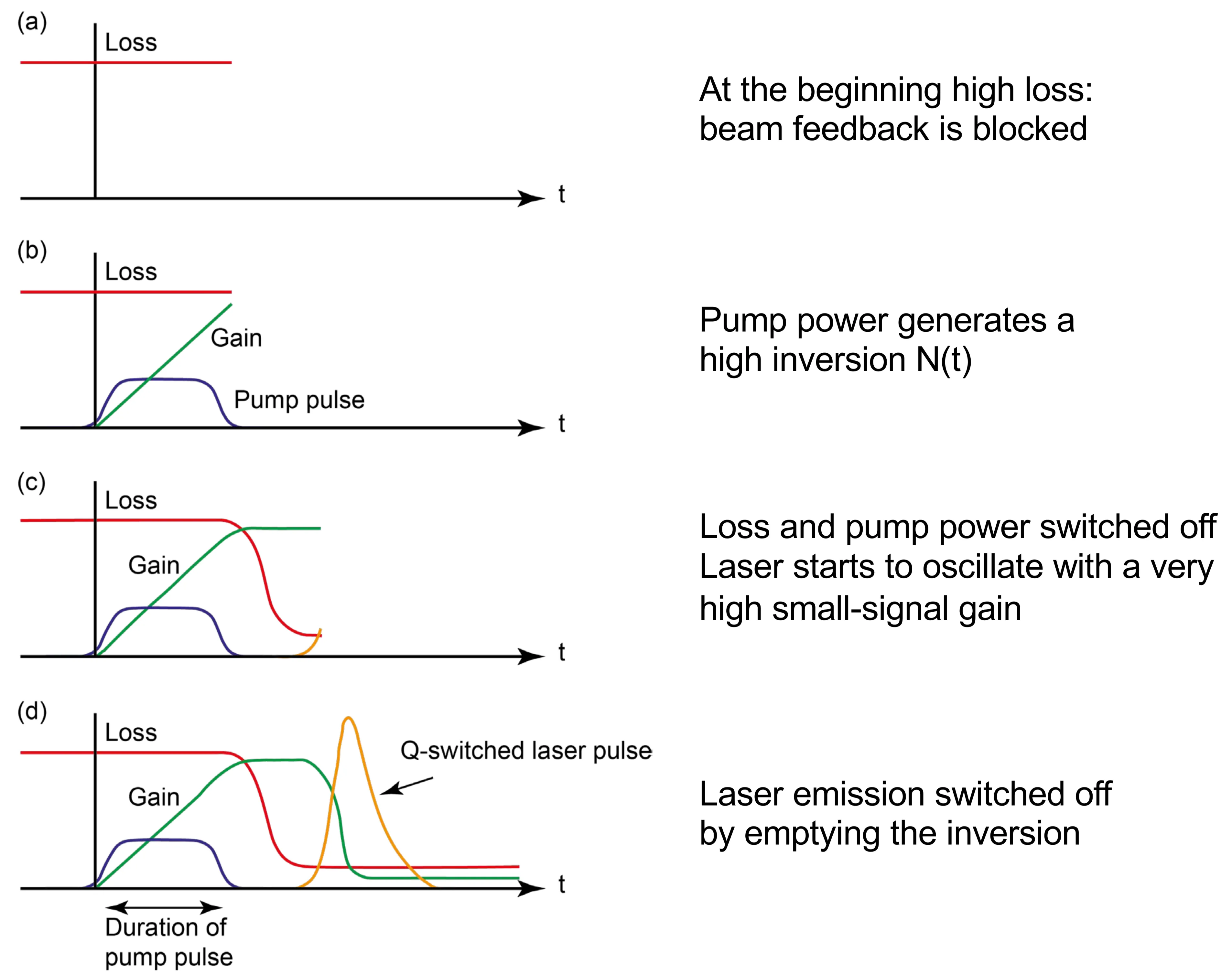
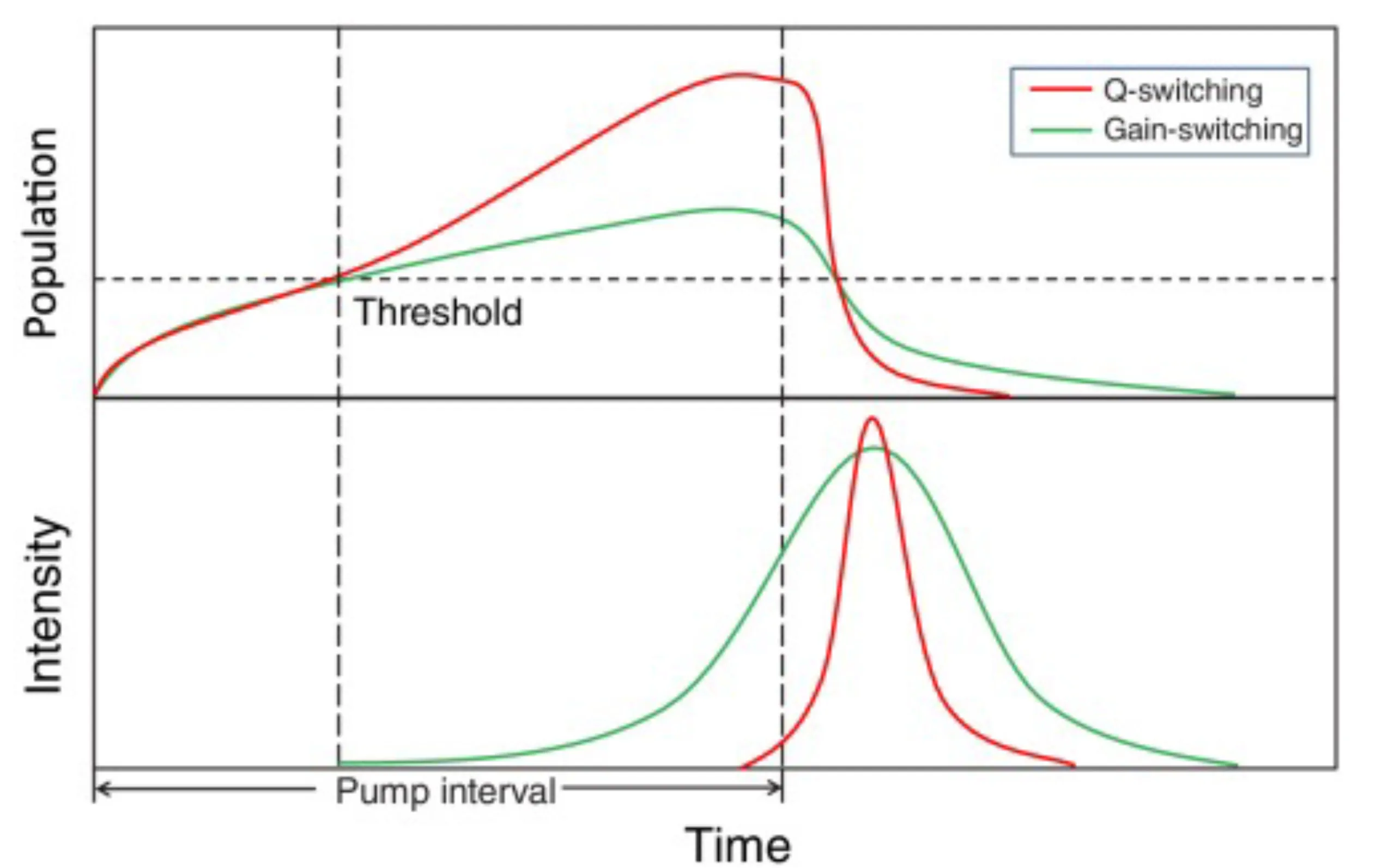
- Mode-locking (active/passive): This technique allows the generation of the shortest pulses directly from a laser cavity, routinely reaching picosecond and femtosecond durations. It involves forcing many longitudinal modes of the laser cavity to oscillate with a fixed phase relationship ("phase-locking"). The coherent superposition of these phase-locked modes results in constructive interference at specific points in time, forming a train of ultrashort pulses. The individual pulse duration is inversely proportional to the total locked spectral bandwidth (the range of frequencies of the phase-locked modes). The temporal spacing between pulses in the train is given by the cavity round-trip time
for a linear cavity of length . The discussion of this topic goes well beyond this introductory course and is treated in extensive detail in Ultrafast Laser Physics.
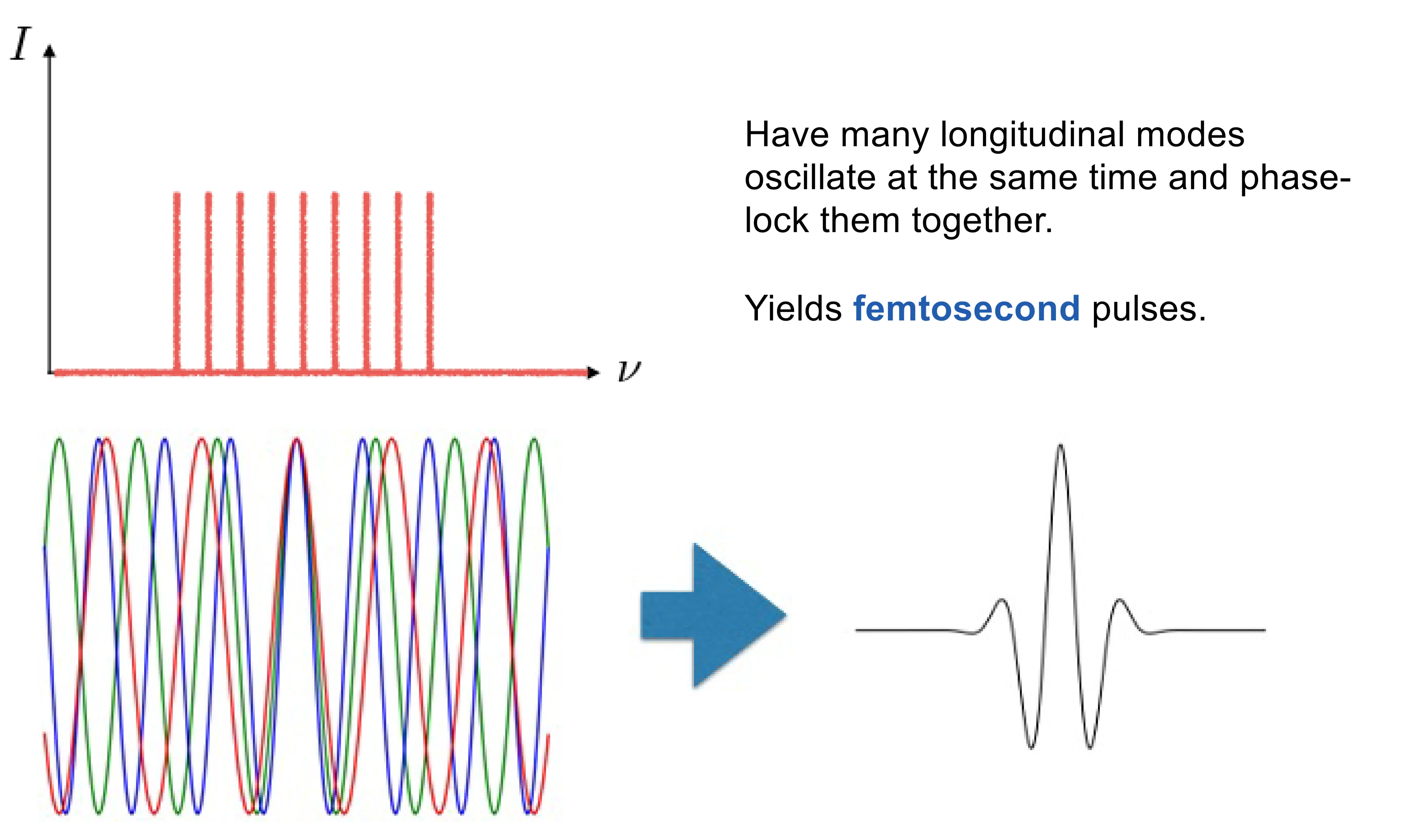
Mode-locking can be achieved in two main ways:- Active mode-locking: An intracavity device (such as an acousto-optic or electro-optic modulator) actively modulates the resonator losses (or gain) at a frequency equal to the FSR (
). This creates short "windows" of net gain once per round trip, forcing the lasing modes to acquire specific phases that lead to pulsed operation. - Passive mode-locking: This relies on nonlinear optical elements within the laser cavity whose properties change with light intensity. A common example is a saturable absorber, which has lower loss for higher intensity. An initial intensity fluctuation (pulse) experiences less loss than CW light, is amplified, and can grow to saturate the gain, eventually forming a stable ultrashort pulse circulating in the cavity. Kerr-lens mode-locking (KLM), which exploits the self-focusing effect in a Kerr medium, and semiconductor saturable absorber mirrors (SESAMs) are widely used passive mode-locking techniques.
- Active mode-locking: An intracavity device (such as an acousto-optic or electro-optic modulator) actively modulates the resonator losses (or gain) at a frequency equal to the FSR (
8.10 Examples of Lasers
There are many types of lasers, with the ruby and Nd:glass lasers having already been mentioned. The following figures and table show some more common types of lasers and some of their typical parameters:
| Laser | Type | Wavelength(s) | Operation Mode | Output Power |
|---|---|---|---|---|
| ArF, KrF, XeCl, XeF | Gas (Excimer) | Pulsed (ns) | ||
| Nitrogen ( |
Gas | Pulsed (ns) | ||
| Dye | Liquid | CW, Pulsed (ps-fs) | ||
| GaN (diode) | Semiconductor | CW, Pulsed | ||
| Argon-ion | Gas (Ion) | CW | ||
| HeNe | Gas | CW | ||
| AlGaInP, AlGaAs (diode) | Semiconductor | CW, Pulsed | mW - tens of W | |
| Ti:sapphire | Solid-state | CW, Pulsed (fs-ps) | ||
| Yb:YAG | Solid-state | CW, Pulsed (ps-fs) | W - kW | |
| Yb-doped glass fibre | Fibre | CW, Pulsed (fs-ns) | W - multi-kW | |
| Nd:YAG | Solid-state | CW, Pulsed (ns-ps) | W - multi-kW | |
| Nd:glass | Solid-state | Pulsed (ns-ps) | High Energy (kJ-MJ) | |
| InGaAs(P) (diode) | Semiconductor | CW, Pulsed | mW - W | |
| Er-doped glass fibre | Fibre | CW, Pulsed | mW - tens of W | |
| Tm:YAG, Ho:YAG | Solid-state | Pulsed ( |
W - tens of W | |
| Solid-state | CW, Pulsed (fs-ps) | |||
| Gas (Molecular) | CW, Pulsed ( |
W - multi-kW |
The following figure shows some laser gain bandwidths for common solid-state laser materials:
Note that Ti:Al
